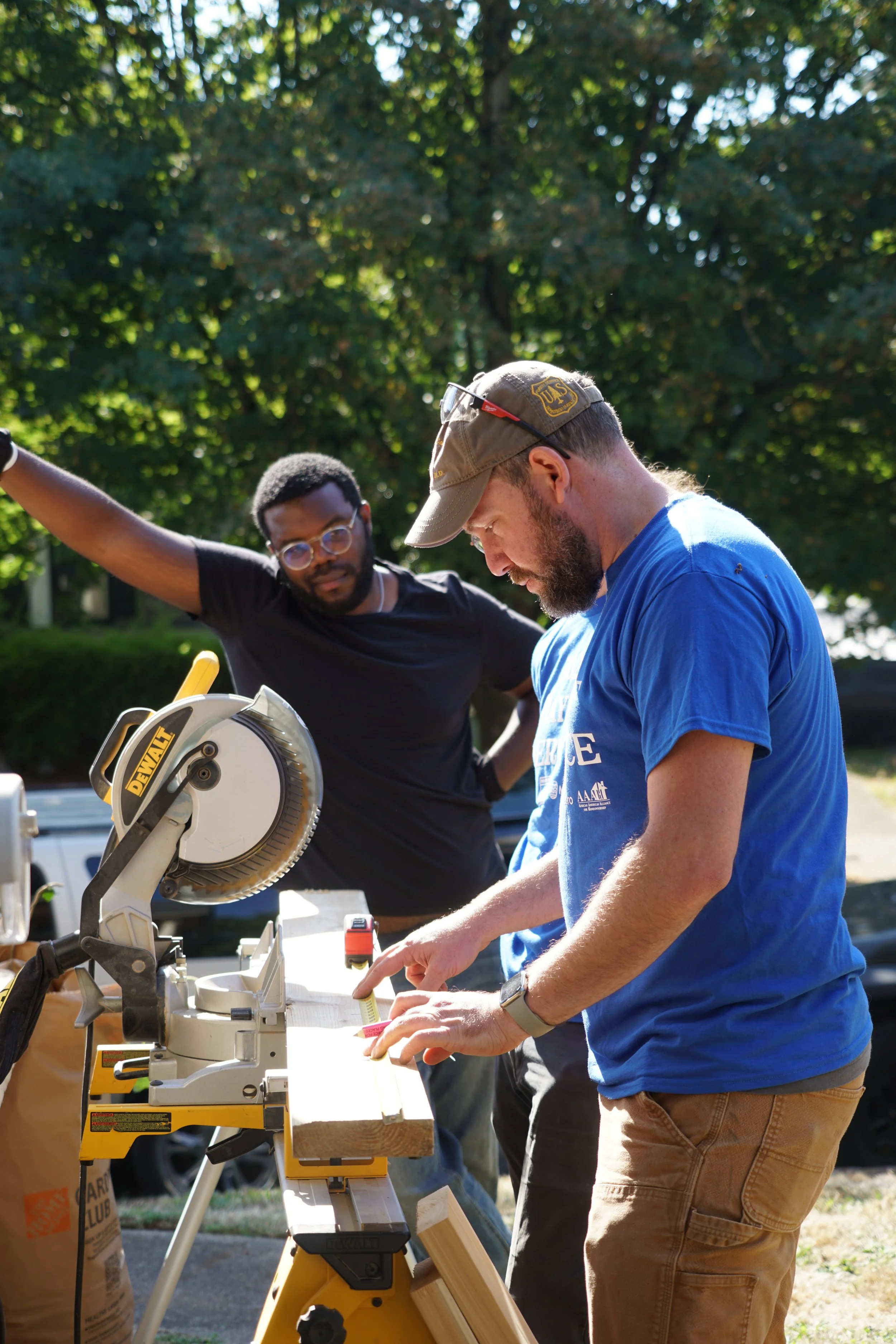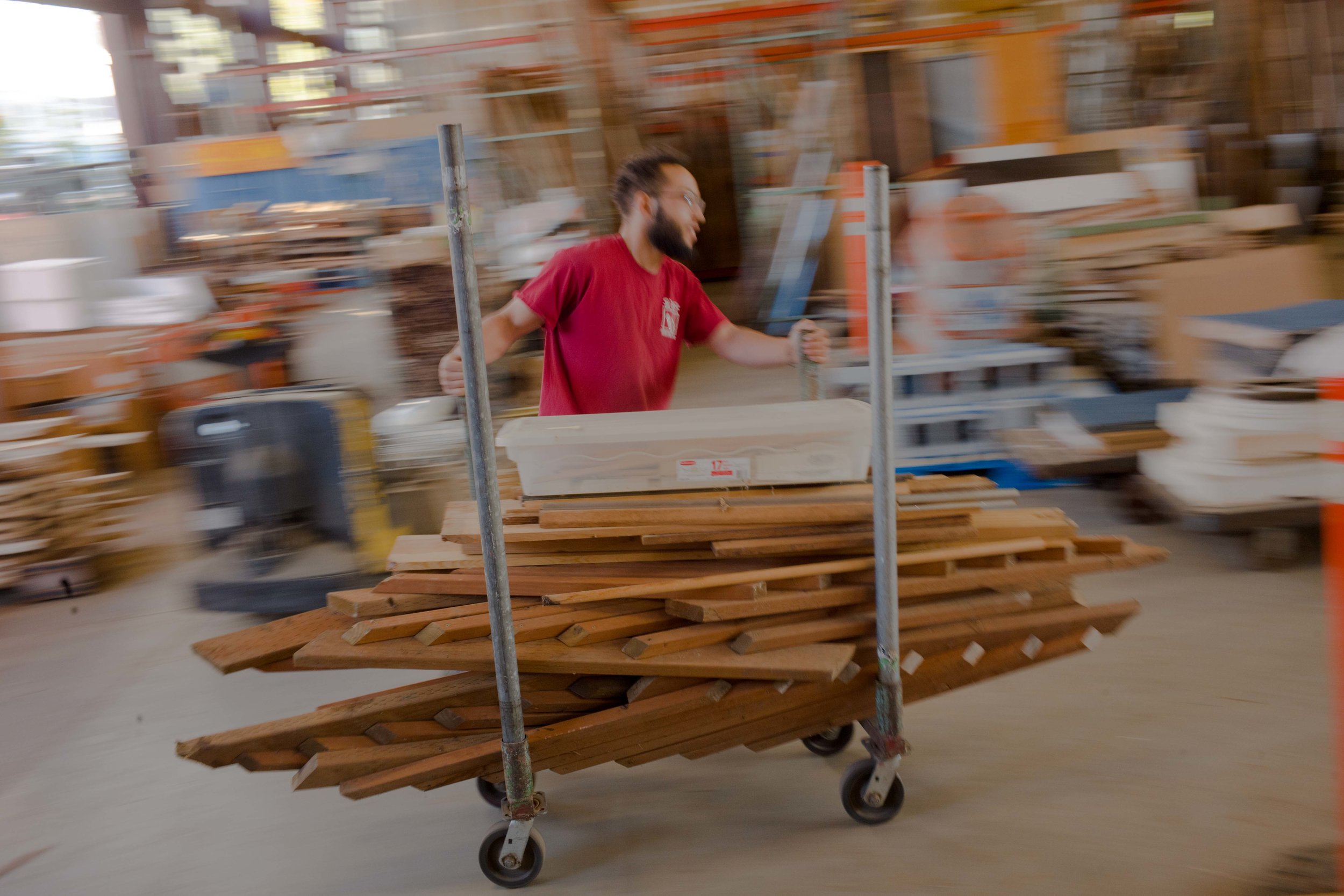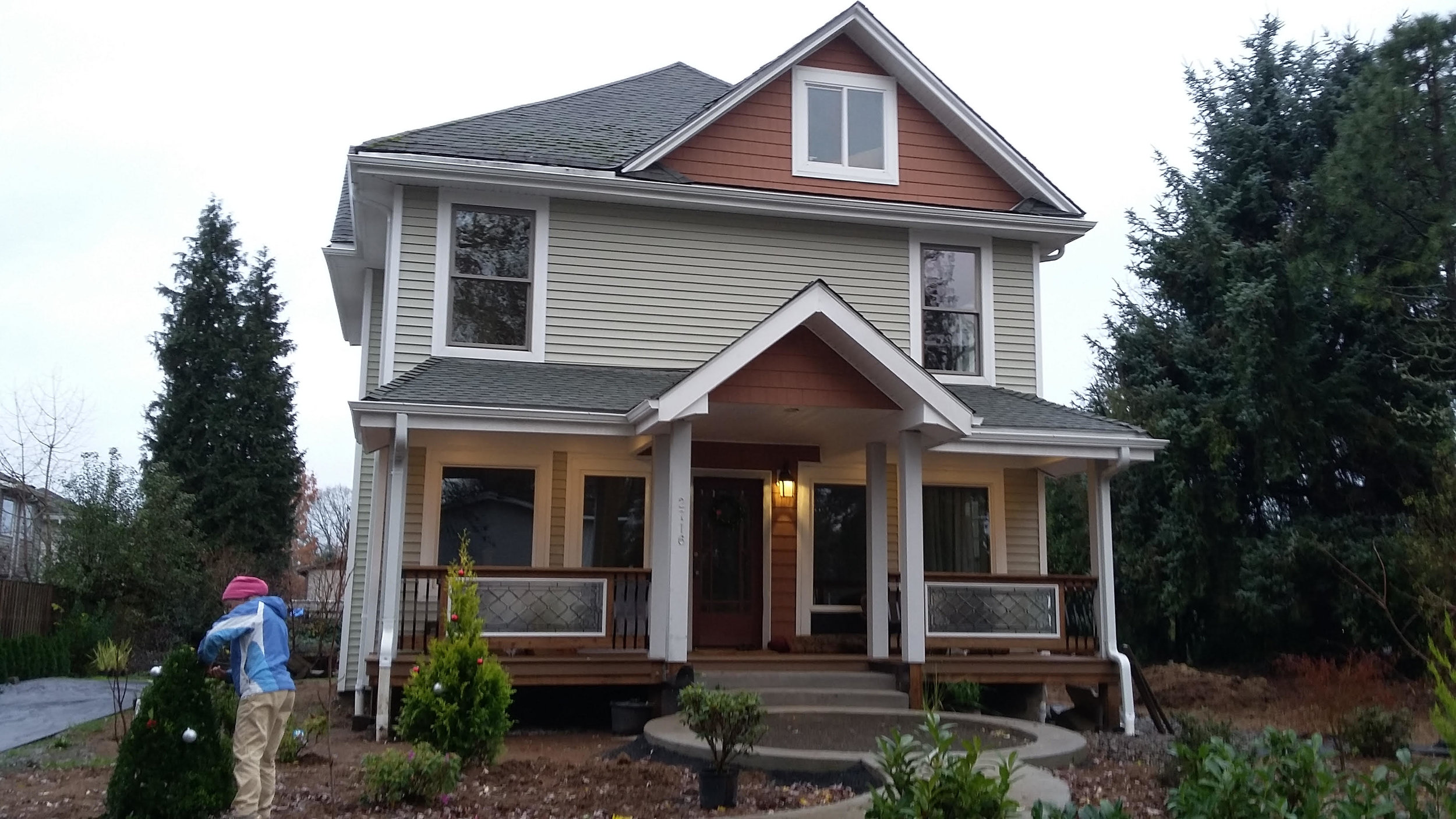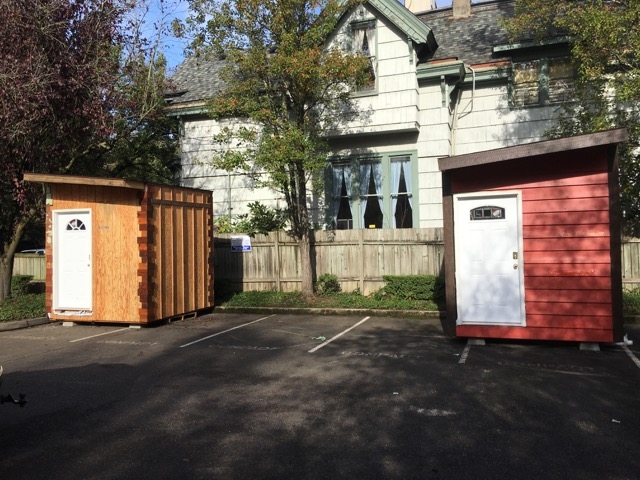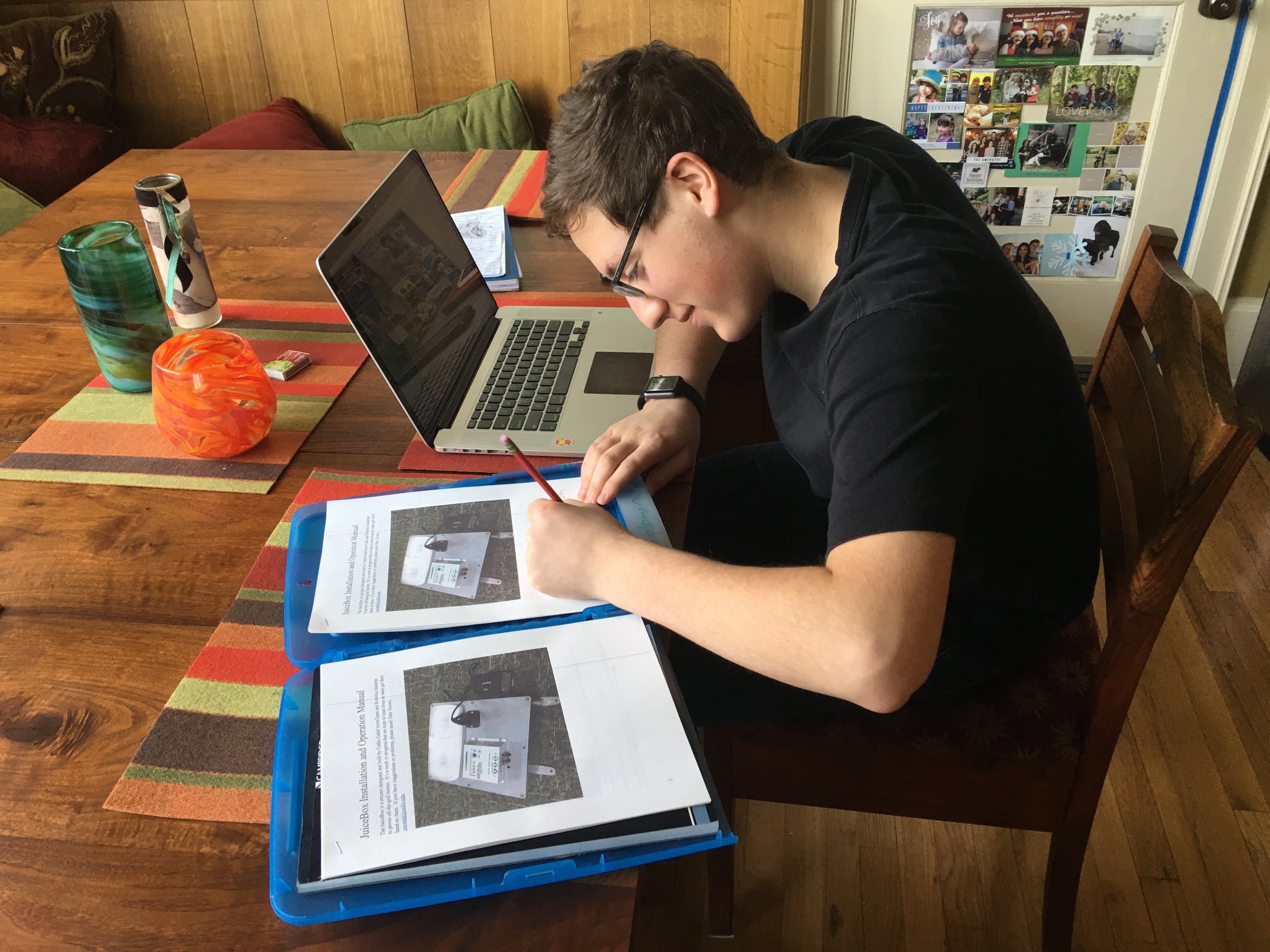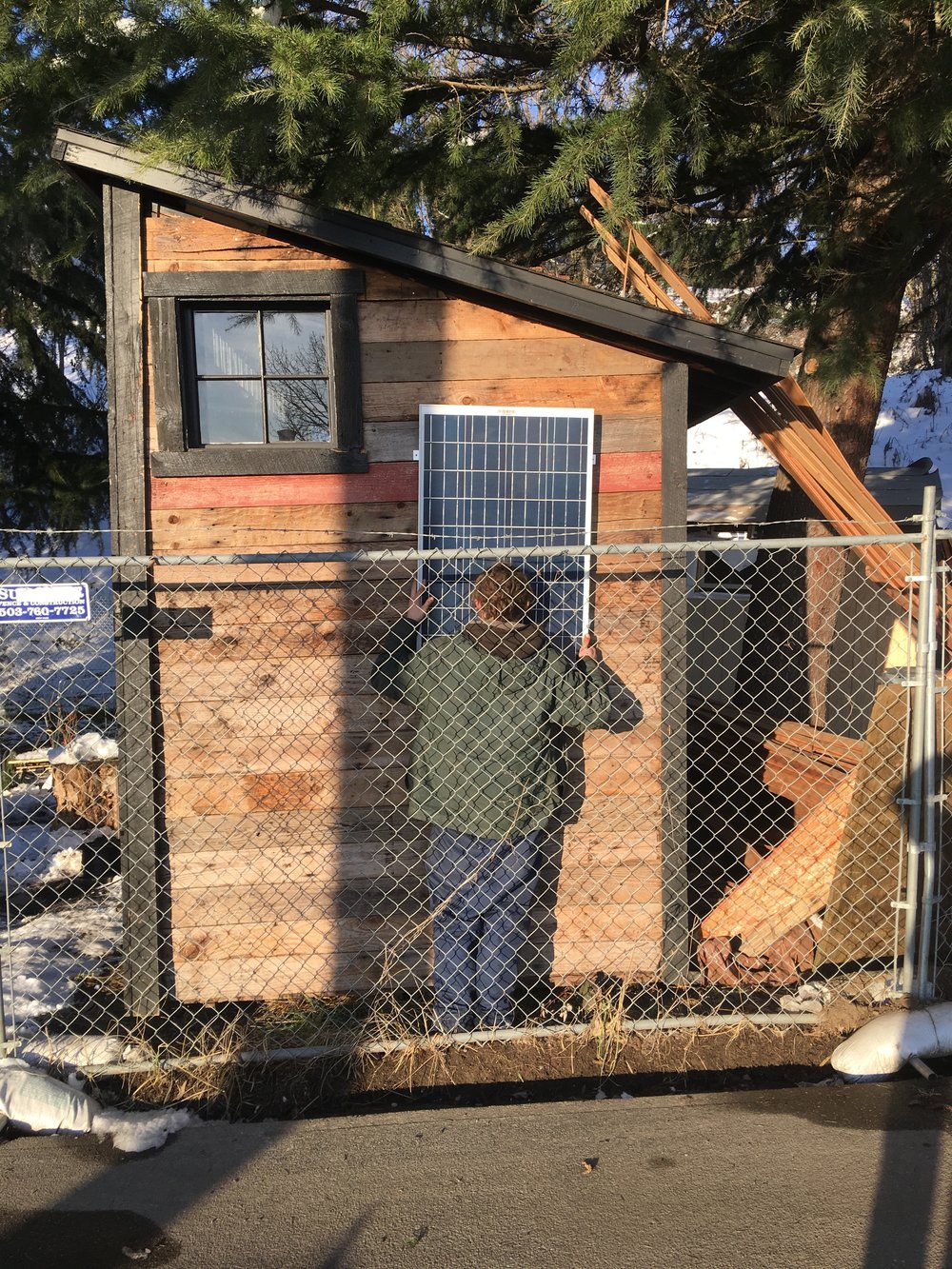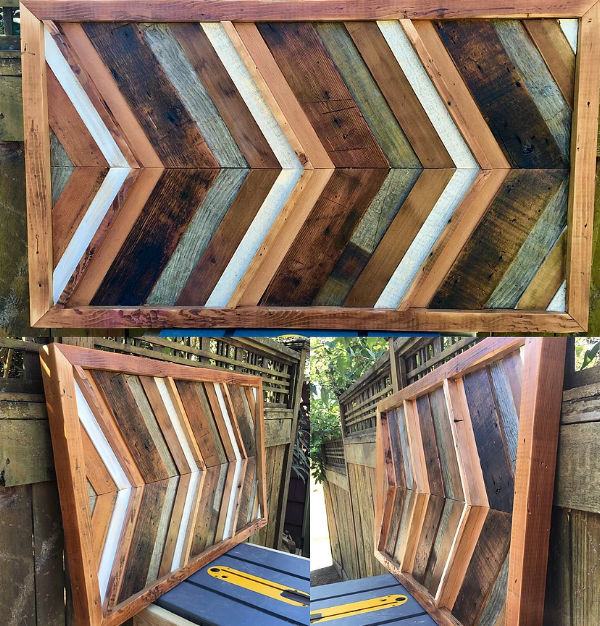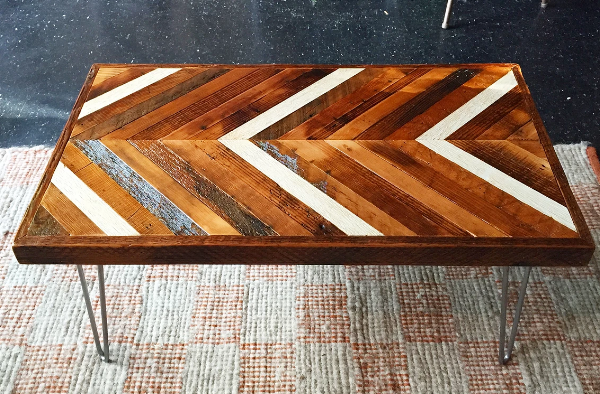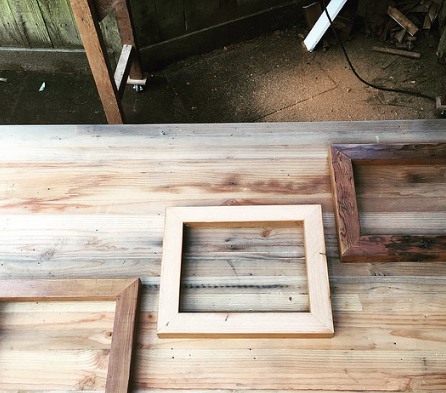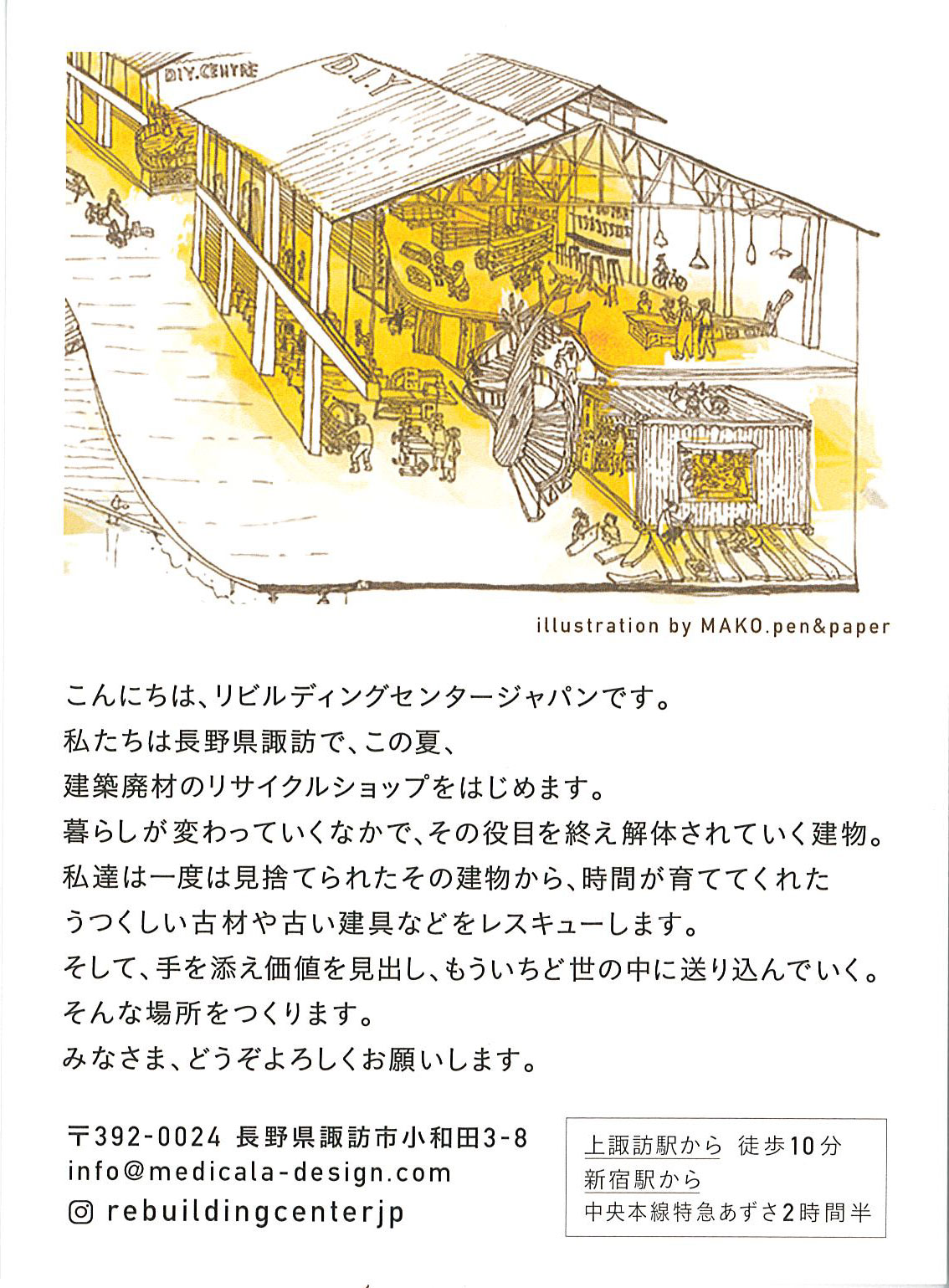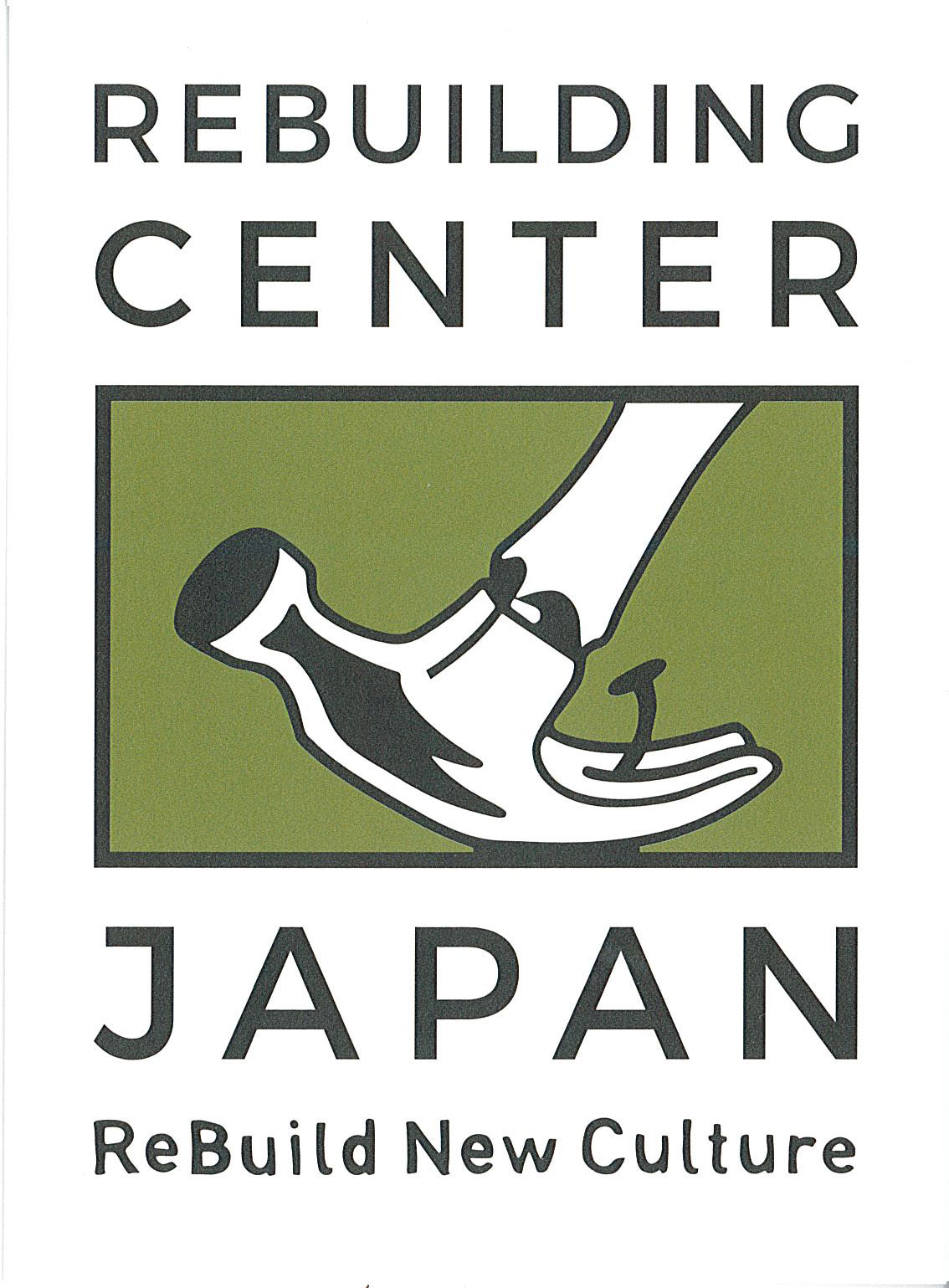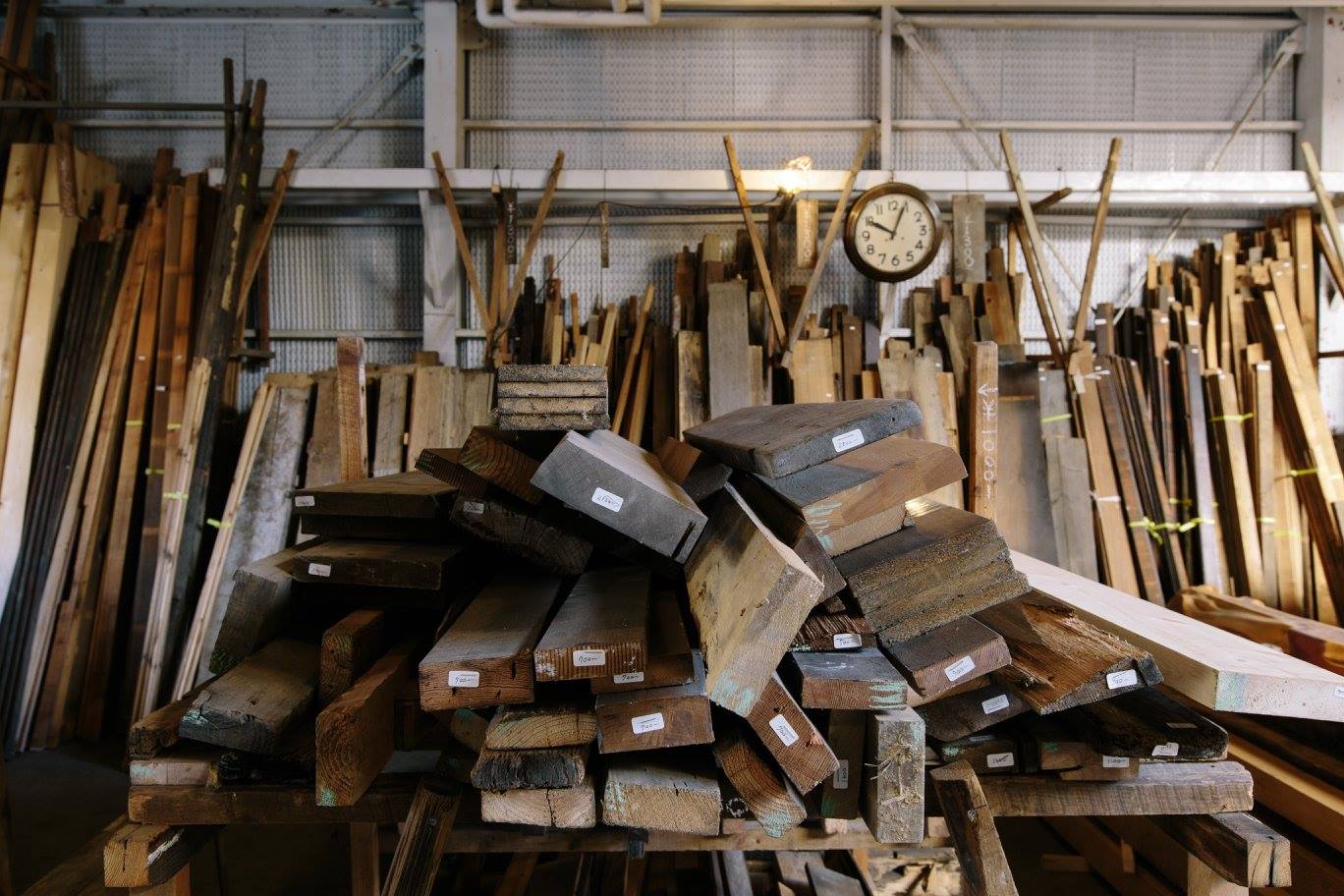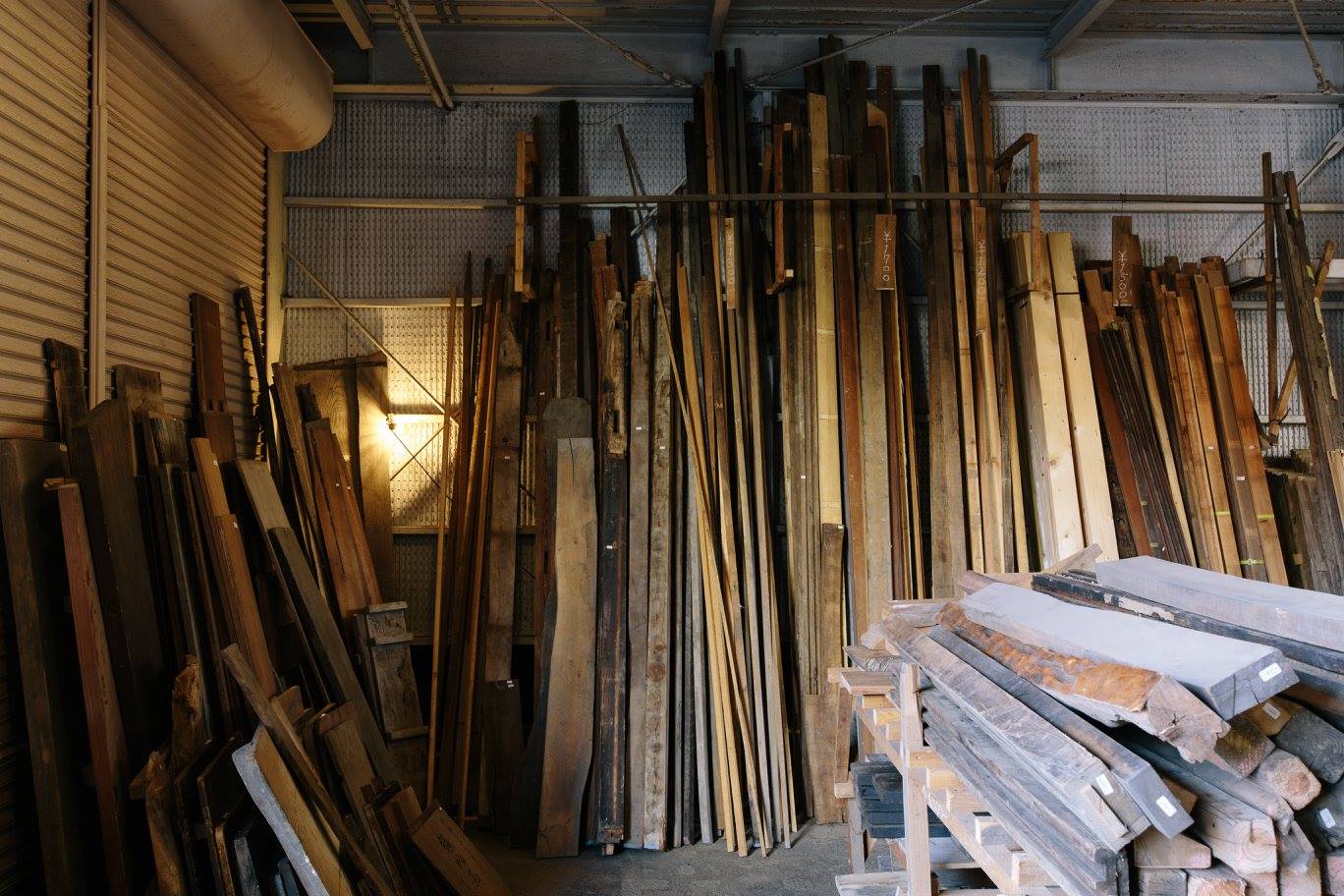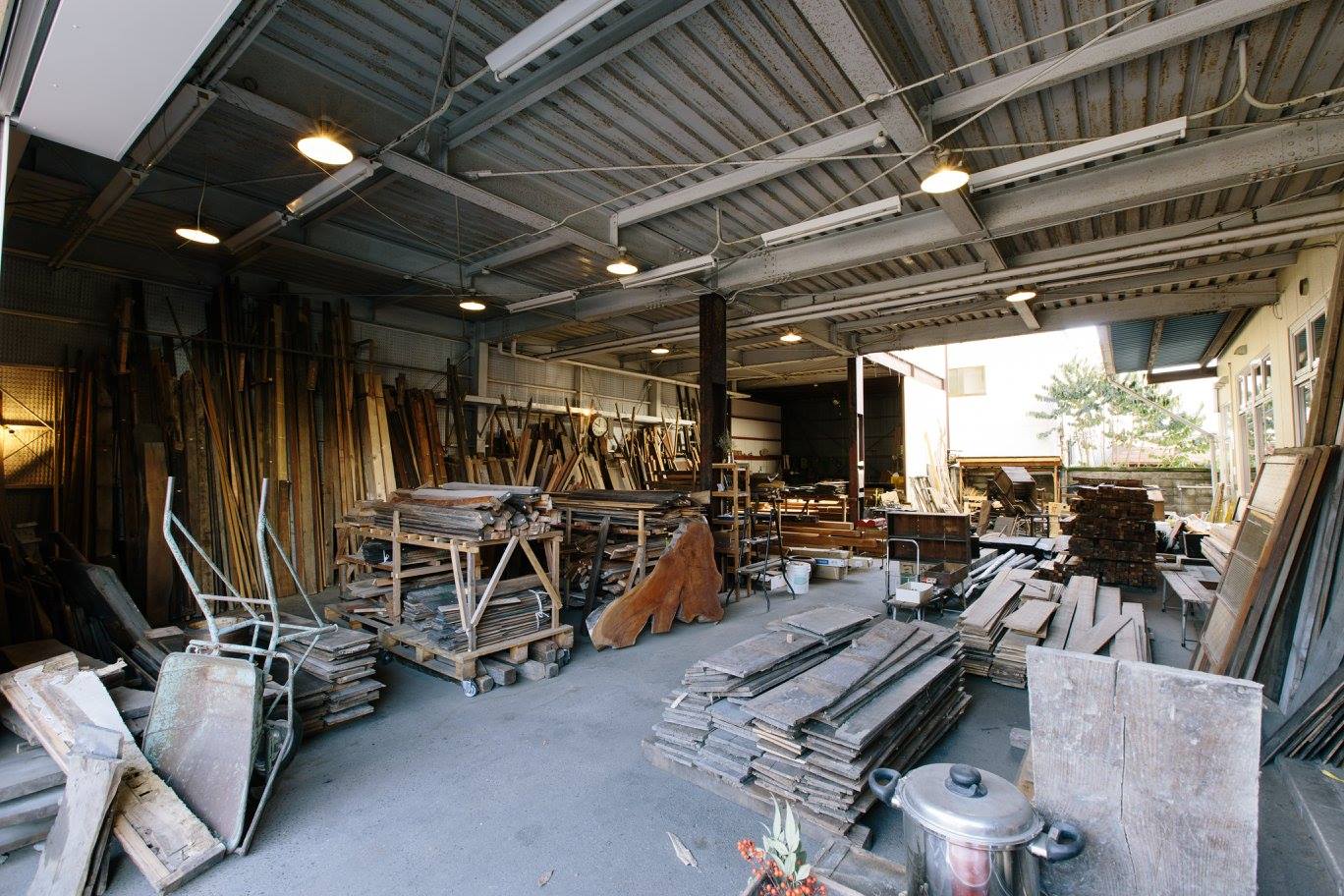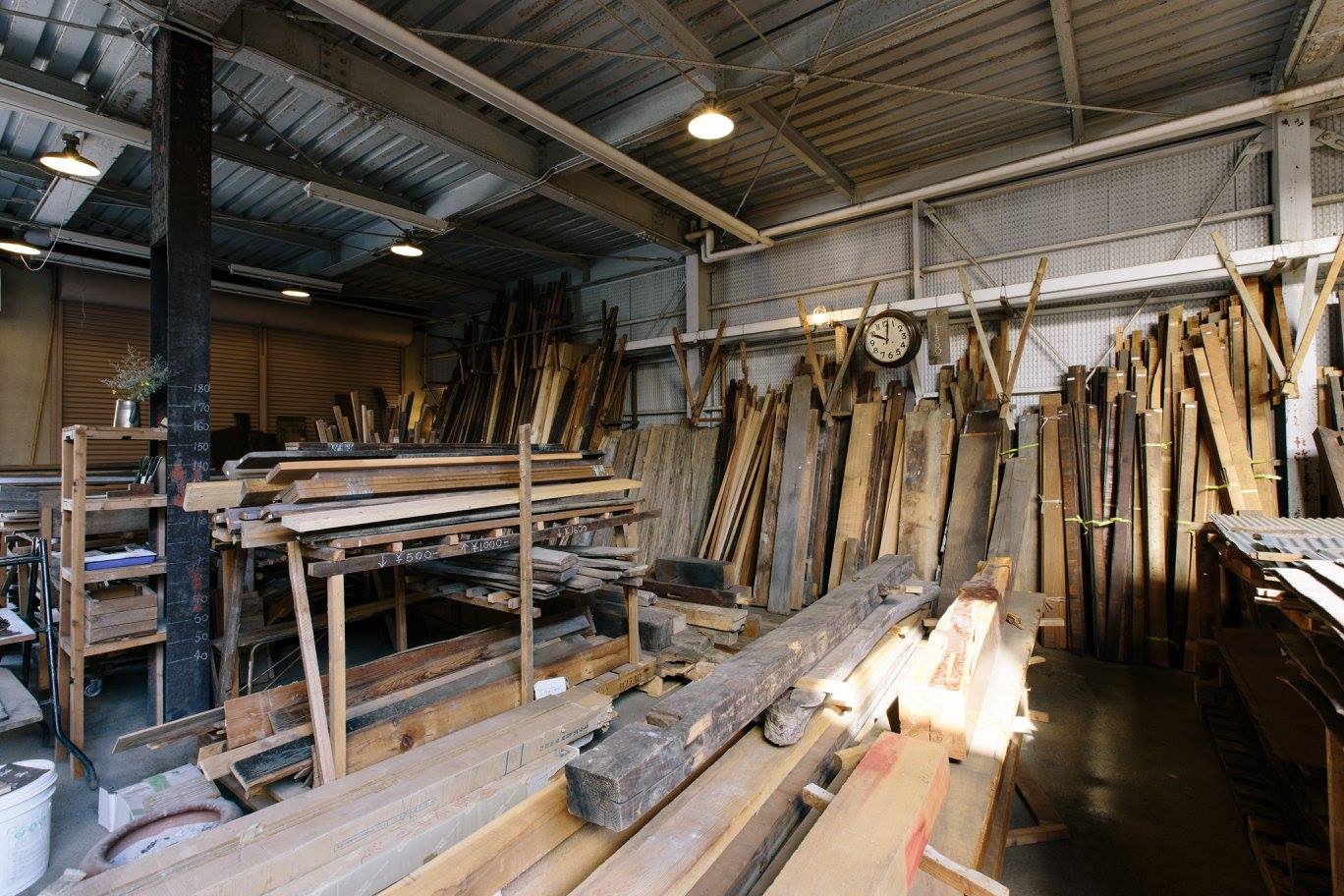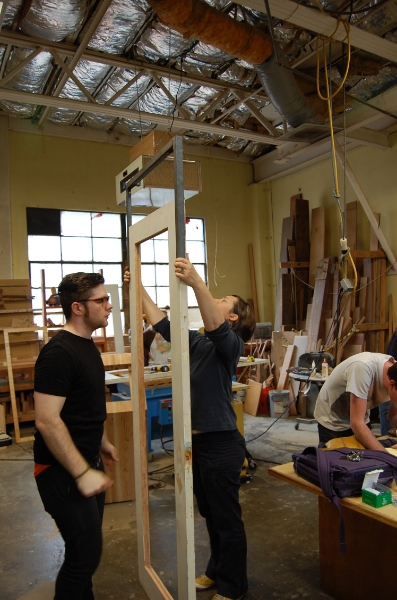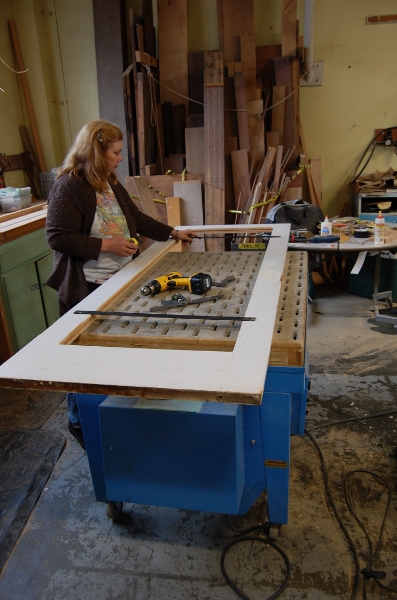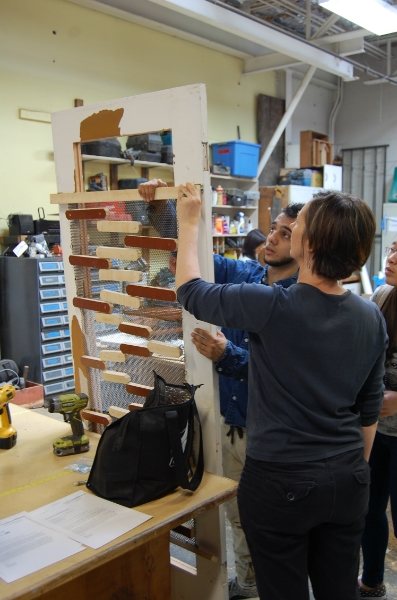What’s one of the most commonly encountered types of reused items in the United States? Cars! So, why do people reuse cars so frequently and willingly in a country where encouragement to purchase new items is everywhere? Are people buying used cars because they care deeply about avoiding the resource extraction required to make a new car? Is the climate crisis fueling the used car market? Hardly.
At the Intersection of Sustainability and Design
At ReBuilding Center, equity, accessibility, home repair education, and waste reduction are pillars of climate justice. But what holds us together is our culture of scrappiness and joy in what we do. Creative reuse, be it in art, craft, or design, is a reflection of this ethos, of our belief that sustainable living can be fun as well as responsible.
Housing is Climate Justice
It’s Earth Month! And since Earth is our one and only home, there’s no better time to talk about the strong connection between housing and climate justice. Healthy, decent, affordable, sustainable housing MUST be at the core of the climate transition. However, we’ve begun to see some challenges in this work.
Now at ReBuilding Center: From Excess to Access!
ReBuilding Center is excited to announce a new program to help BIPOC homeowners and homeowners with disabilities repair and retain their homes. No one should lose their home because they cannot afford to make repairs, so we’ve partnered with the Environmental Protection Agency and the City of Portland to help make critical home repairs possible for folx!
Green
By: Alex Rhodes (ReBuilding Center Salvage Specialist)
“Green”—a word I have been grappling with and redefining for years, it seems. Most commonly thought of as a color…the color of so many beautiful plants and landscapes, but especially known in our society as the color of money. What I’ve found is that “green” is a catch-all buzzword for the movement for changing consciousness towards the environment, particularly where it relates to the economy. It is purposefully vague and has caught on in many types of industries such as small businesses, construction, technology, education, energy, and even agriculture. If you’re a company or nonprofit in one of these industries, there are a variety of incentives to market yourself as “Green.”
But what does it mean for a job to be Green? Well, let’s take for example our organization, the ReBuilding Center. We are striving to give our staff living wages, strong benefits, and a socially progressive culture in our workplace. We are strongly tied to the construction industry while being leaders in environmentally conscious practices with our deconstructions services as well as our store, both which promote the idea of Reuse. In other words, we bring social, economic, and environmental justice into our way of operating. All of this makes us the textbook example of an organization that is Green.
The Green Workforce Collaborative (GWC) seeks to guide the most historically marginalized young adults in Black and Native communities of the Portland area into stable, decent-paying jobs. Currently, these good jobs are overwhelmingly Green jobs. As you may be aware, Black and Native people have been oppressed for way too long and we need to reverse the trend. There are traumas, lack of a positive network, and scarcity of intergenerational wealth that disproportionately follows all of us whether we like it or not.
How the GWC plans to do this is by raising environmental awareness, a skill many employers say potential employees lack. During a five-week long program that utilizes the nationally-accredited Roots of Success Curriculum (piloted in 2018), the “Green Workforce Academy” provides a down-to-earth understanding of the environmental issues that affect us all. To bring the subject closer to home, we spend half of the program going out and meeting with potential employers to engage in hands-on events. The job doesn’t end there. We serve as mentors as graduates transition into their new careers and provide them with references and guidance.
As a young adult from a diverse, low-income background who has taken the unbeaten path of studying the issues around the environment, working at a Green job such as with the ReBuilding Center, I have never been so certain of the direction I’m headed. Understanding the bigger picture of how the environment affects us has played a central role in changing my life. I can already see it starting to change my peers participating in the Green Workforce Academy program. Participating in this project has been deeply fulfilling, and I foresee the Green Workforce Collaborative having the potential to be a model in job creation moving forward as the Green wave rolling over our country brings about an economy that reflects the realities of our environment.
Bay Area Salvage
By: Chris Larsen (ReBuilding Center Process Improvement Coordinator)
During the recent Thanksgiving break I had the opportunity to tour some of the Bay Area’s largest salvaged and reused building materials stores. The reuse store landscape in the Bay Area is an eclectic mix of for profit and nonprofit organizations of a wide range of scales and with varied specialties. All the organizations I visited are united through the sale of used building materials and all have operated for over twenty years. Here is a small snapshot of the Bay Area’s salvage landscape, which serves as information and inspiration for the ReBuilding Center’s operations in Portland:
This and That Building Materials
For Profit
Founded: 1997
San Pablo
Mission: “We are committed to preserving reusable building materials and offering them to our customers at a fraction of retail prices. Reduce Reuse and Recycle”
This and That Building Materials is an unpretentious, no frills, salvaged goods retailer. The organization has a huge stock of almost every building material imaginable. The stock is generally relatively common goods, with occasional high-end and antique materials. The organization is unique in having a dedicated employee and the accompanying machinery to produce new custom door jambs for used and new doors. Although for profit, the store had a decided community feeling with folks chatting and catching up while others were shopping around for the next deal.
For Profit
Founded: 1980
Berkeley
Mission- “To end the age of waste”
“If you're not for Zero Waste, how much waste are you for?”
Urban Ore is a Berkeley institution. The organization is beloved by Bay Area residence and is one of the largest salvage organizations I visited. Urban Ore runs a diverse business, selling reused building materials as well as antiques, home goods ranging from clothing to kitchenware, and arts and media ranging from books to creative reuse arts materials. The organization has a dedicated receiving department for sorting items before they reach the public, a metals recycling facility as well as a partnership with the local transfer station to allow gleaning of materials prior to disposal.
For Profit
Founded: 1974
Berkeley
Mission- “Ohmega Salvage builds community through commerce by being a model of reuse, recycling and social exchange. We preserve old-quality items and resources for our customers.”
Ohmega Salvage is another such Berkeley Institution, perhaps even more so being founded in 1974. The organization appears in such famous counter cultural books as Lloyd Kahn’s alternative architectural work “Shelter”. Today the organization primarily deals in genuine antique and vintage architectural salvage, ranging from mantles and stained glass windows to door hardware and clawfoot tubs. They also do extensive rewiring of quality light fixtures.
Non-profit
Founded: 1994
San Francisco
Mission- “Building Resources is a not for profit organization dedicated to providing our community with low cost high quality materials, in a friendly, clean and organized setting.”
Building Resources is San Francisco’s only non-profit salvage store, and may be the singular affordable option for salvage in the City. Building Resources runs a small yard of diverse building salvage as well as an alternative glass recycling program making tumbled art glass, as well as housing an art gallery. In San Francisco’s increasingly dense, high-priced and fast-paced market, Building Resources stands as a beacon of equality, affordability, environmentalism, and creativity within the city.
Non-profit
Founded: 1993
Oakland
Mission- “The ReUse People reduces the solid waste stream and changes the way the built environment is renewed by salvaging building materials and distributing them for reuse”
The ReUse people is a national organization doing deconstruction and sales of used building materials. It is also the cliffhanger in my visit to the Bay Area, as I did not manage through a combination of traffic and altered holiday hours to get into the store! So more to look forward to seeing soon.
June 2017 Volunteer Opportunities
Join the ReBuilding Center in the second annual Day of Service, meet other Portlanders and enjoy a discounted happy hour during our Building Community Through Reuse social night, help build a ReBuilding Center theme park for the Alberta Last Thursday, or prep for ReFind Adult Education classes!
Day of Service
SATURDAY, JUNE 10TH
Every year the ReBuilding Center joins with the African American Alliance for Homeownership to bring the community an annual Day of Service, offering minor repairs to neighborhood homeowners. These services are provided to our neighbors who are at risk of being displaced from their homes due to their need for repairs. In 2016, volunteers proudly completed 10 projects on 5 different properties, tackling a wide range of issues:
- Removal and repair of rotting stairs
- Demo and re-pouring of concrete stairs
- Cleaning up overgrown yards
- Installation of handrails
- Mending fence boards
- Sink installation
- Door hanging
- Painting houses
This year the ReBuilding Center plans to take on similar projects with double the number of homes! This is an excellent opportunity for volunteers who would like to learn DIY skills or those with prior building experience who would like to apply their expertise to a greater cause. If you are interested in joining our team to build a healthier more vibrant community please pre-register now to be placed on our list to receive further information, pick preferred projects as they become available, and be considered for a position as one of our Crew Leaders.
LEND A HAND AT OUR MONTHLY DE-NAILING PARTY AND RECEIVE 25% OFF AT STORMBREAKER BREWING
SECOND THURSDAY of every month
6PM - 8PM
The ReBuilding Center invites you to join us for an evening of socializing and de-nailing on the second Thursday of each month from 6pm to 8pm. No need to be registered as one of our existing volunteers, this monthly event is open to the public. Get some rewarding hands-on experience while keeping usable building materials from making their way into landfills and waste streams. Meet and socialize with like-minded individuals! If you are looking for a great way to expand your friend base here in the Portland community then this monthly mixer is for you! After the de-nailing has concluded, regroup with your fellow volunteers accross the street at Stormbreaker Brewing and enjoy an additional 25% off for your contribution.
To sign up, please RSVP with David Lowe, our Volunteer Services Manager:
dave@rebuildingcenter.org
BUILD A THEME PARK WITH THE REBUILDING CENTER FOR LAST THURSDAYS ON ALBERTA
MONDAYS, TUESDAYS, WEDNESDAYS, AND FRIDAYS
10AM TO 4PM
JUNE 5TH - JUNE 26TH
Work with us to build “ReBuilding Center Road,” a 90’ x 10’ attraction that will highlight salvaged building materials in fun and creative ways during the Alberta Street Last Thursday (June-August). Help repair our trade show booths and help make them mobile/transportable, plus brainstorm building projects that will enhance the Last-Thursday-goers' experience.
We need volunteers to help create structures, games, and other interactive activities with used building materials. Some carpentry know-how is helpful, but not required. We will supply all needed tools, materials, safety equipment, and guidance.
If you would like to get your hands on this incredible opportunity, email ashley@rebuildingcenter.org with the subject line "ReBuilding Center Road." Please tell a little about your building, repair and design experience, as well as why you are interested in joining our team.
HELP US PREPARE FOR YOUTH AND ADULT CLASSES IN OUR REFIND EDUCATION SHOP
EVERY MONDAY & FRIDAY AT 12:00pm
The ReBuilding Center is looking for help in our Refind Education shop getting tools and material ready in preparation for upcoming youth and adult classes.
To sign up, email the ReFind Education Coordinator, Aaron Green at: aaron@rebuildingcenter.org
For more information on any of the volunteer opportunities listed above or to check out other ways you can help build community through reuse follow these links:
EXISTING VOLUNTEERS
NEW VOLUNTEERS
May/June 2017 Volunteer Opportunities
Join the ReBuilding Center in the second annual Day of Service, meet other Portlanders and enjoy a discounted happy hour during our Building Community Through Reuse social night, help build a ReBuilding Center theme park for the Alberta Last Thursday, or prep for ReFind Adult Education classes!
LATINO HOME FAIR
Saturday June 3rd
ReBuilding Center will be at Madison High School on June 3rd for the Latino Home Fair. Sign up to represent us at this event. Spanish lingo a BIG plusIf you haven’t tabled with us before, get in touch with dave@rebuildingcenter.org to learn a bit more. It’s fun and easy.
Latino Home Fair is Hacienda’s biggest annual event that assembles a team of trustworthy professionals every year to provide useful resources to support future homeowners.
Hacienda CDC's Homeownership Support Program is a HUD-approved housing counseling agency. They provide group education and one-on-one counseling to first-time homebuyers and homeowners at risk of foreclosure. Hacienda CDC services are available to all Oregon residents.
The cultural atmosphere makes this annual fair a great family event for all with food, music, raffles and prizes (like a one month rental and down payment assistance.)
You can schedule yourself by visiting you schedule through the Volunteer Portal, or by emailing Dave directly.
Day of Service
SATURDAY, JUNE 10TH
Every year the ReBuilding Center joins with the African American Alliance for Homeownership to bring the community an annual Day of Service, offering minor repairs to neighborhood homeowners. These services are provided to our neighbors who are at risk of being displaced from their homes due to their need for repairs. In 2016, volunteers proudly completed 10 projects on 5 different properties, tackling a wide range of issues:
- Removal and repair of rotting stairs
- Demo and re-pouring of concrete stairs
- Cleaning up overgrown yards
- Installation of handrails
- Mending fence boards
- Sink installation
- Door hanging
- Painting houses
This year the ReBuilding Center plans to take on similar projects with double the number of homes! This is an excellent opportunity for volunteers who would like to learn DIY skills or those with prior building experience who would like to apply their expertise to a greater cause. If you are interested in joining our team to build a healthier more vibrant community please pre-register now to be placed on our list to receive further information, pick preferred projects as they become available, and be considered for a position as one of our Crew Leaders.
LEND A HAND AT OUR MONTHLY DE-NAILING PARTY AND RECEIVE 25% OFF AT STORMBREAKER BREWING
SECOND THURSDAY of every month
6PM - 8PM
The ReBuilding Center invites you to join us for an evening of socializing and de-nailing on the second Thursday of each month from 6pm to 8pm. No need to be registered as one of our existing volunteers, this monthly event is open to the public. Get some rewarding hands-on experience while keeping usable building materials from making their way into landfills and waste streams. Meet and socialize with like-minded individuals! If you are looking for a great way to expand your friend base here in the Portland community then this monthly mixer is for you! After the de-nailing has concluded, regroup with your fellow volunteers across the street at Stormbreaker Brewing and enjoy an additional 25% off for your contribution.
To sign up, please RSVP with David Lowe, our Volunteer Services Manager:
dave@rebuildingcenter.org
HELP US PREPARE FOR YOUTH AND ADULT CLASSES IN OUR REFIND EDUCATION SHOP
EVERY MONDAY & FRIDAY AT 12:00pm
The ReBuilding Center is looking for help in our Refind Education shop getting tools and material ready in preparation for upcoming youth and adult classes.
To sign up, email the ReFind Education Coordinator, Aaron Green at: aaron@rebuildingcenter.org
For more information on any of the volunteer opportunities listed above or to check out other ways you can help build community through reuse follow these links:
EXISTING VOLUNTEERS
NEW VOLUNTEERS
Jami and Kourosh Remodel
This summer Jami and Kourosh Poumad completed a 4,300-square-foot home restoration using as many recycled materials as they could. They wrote and complimented the staff of the ReBuilding Center for helping them select the following, all of which were used in the remodel.
Kitchen Cabinets
Corian kitchen counter and sink
24 exterior windows
3 entry doors
11 interior door knobs
4 bathroom showers, sinks and hardware
9 Cast iron radiators
Stair railing
21 indoor light fixtures
Dishwasher
Stove
Fridge
Microwave
All deck straps
20 bags of insulation
BEFORE
AFTER
Jami and Kourosh kindly responded to questions we had that explained in detail their experience and reasons for using recycled materials from the ReBuilding Center:
Is this the first time you have used recycled items in your home?
This is not the first time. Whenever we have a repair or change at home the ReBuilding Center/recycled materials are our first choice.
For items that had to be “built-in," like the kitchen cabinets and countertops, the 24 exterior windows, and the stair railing, did you have any problem getting them to fit? Or did you have to modify them in some way?
Yes. The windows all had to be re–framed and one of the kitchen cabinets was converted to a sink module since the "set" didn’t include it. We also installed a kick plate at the base. The Corian counter was too long and had to be cut at one end. The stair railing had to be re-drilled and the old holes had to be filled in with wood putty, then re-stained. (The metal rails were new, not recycled)
Why do you use recycled materials?
Lower cost and we like to bring products and materials “back to life.”
Have you used sources other than the ReBuilding Center to obtain/purchase items?
Yes—Habitat for Humanity in Portland, Cedar Hills and Forest Grove; Goodwill; and Craigslist.
Do you have a philosophy that supports your use of recycled building materials?
Considering a great deal of effort and expertise goes into manufacturing a walnut door or a leaded glass window, it’s a shame to send a craftperson’s work to a landfill. We find that often a recycled item is just as good as or better than new [materials] and is less expensive. Those savings are passed onto our family and employees, it puts a whole new spin on recycling!
What other things have you purchased from the ReBuilding Center?
1 heavy duty outdoor door and 1 French door for our business
We re-purposed an alabaster hanging bell lamp to a soft table lamp
We installed 3 – 6’x1’ windows in our daylight studio
Insulation for the studio
16 cast iron radiators for our home
Roofing material for our home
A double stove for our home
Of all your purchases of recycled items, which do you like the most?
We like the windows used on the front deck in place of iron balusters. It saved us a lot of money in place of using many balusters. And it gives the home a charming artistic flair without being over the top.
High School Students Power Tiny Homes for the Houseless
High school students from Catlin Gabel are powering tiny homes for the houseless with a project they call “The Juice Box Project!” Check out this 3-minute video and hear from the residents about how this system is helping them get back on their feet!
An innovative solution to off-the-grid communities like Hazelnut Grove, these eco-friendly boxes provide solar powered energy to juice light and electricity, which “allows residents to become more independent, productive and engaged in their communities!” Help The Juice Box Project win this year’s Lexus Eco Challenge by sharing this post! The ReBuilding Center is a proud partner in this initiative.
What Is Juice Box?
Juice Box is an efficient and sustainable way to provide electricity for off-the-grid, portable pods for previously homeless people.
- The shelter "pods" are equipped with 100W solar panels that deliver power to the Juice Box, mounted inside.
- The power of the sun is harnessed to charge an 18 AH 12V battery. Batteries are recycled from FIRST Robotics teams.
- This power can then be used to power devices that plug into a wall outlet (120V AC, 300W max) or 12V DC automotive accessory socket.
- The battery also powers a bright LED light bar mounted on the front of the Juice Box, perfect for illuminating rooms at night, and extending the day of the user.
ANNOUNCING A NEW COMMUNITY OUTREACH PROJECT: MUDBONE GROWN
PORTLAND, OR. (February 3, 2017) — Local start-up MudBone Grown, LLC (MBG) and its partner programs GroundUp Organics, Green A&T have launched a culturally/ethnically-specific urban food systems project at the Oregon Food Bank’s 33rd Ave. Farm. MudBone owners Shantae Johnson and Arthur Shavers are NE Portland natives that made the leap to small farm agriculture early last year.
“We are very excited about our collaboration with Christine Hadekel Outreach Manager with Oregon Food Bank for the opportunity to launch our social enterprise-based start-up farm”, said Johnson, (founder, certified community health worker, doula, and now urban farmer). Arthur, (co-founder, construction “jack-of-all-trades”and professional leathersmith) and I have been dreaming about this for years and we were not sure how things were going to turn out after we left the BUFA (Beginning Urban Farmer Apprenticeship) program last summer.”
“This is a game changer,” says Shavers. “This assistance saves us more than $10,000 of start-up costs that usually keep many people interested in this kind of work, from being able to launch their dream of farming .
With the help from ReBuilding Center’s Community Outreach manager Edward Hill, who happens to have a background in urban farming, Shantae and Arthur in less than 60 days, were able to finish writing a business plan, establish land agreements, and create a farm plan that supported a formal partnership with the Oregon Food Bank on nearly an acre of fully equipped land in NE Portland.
“We are so excited to have Edward and ReBuilding Center on board, their assistance has been instrumental in getting us past many of the barriers we were experiencing to getting an actual farm site in the City and large enough to create sustainable cooperative revenue.”
Additionally, education contracts with Black Parents Initiative (BPI), purchasing agreement with KAIROS School and local Food Prescription programs, and watershed enhancement funding, MudBone Grown is leading an environmental and community economic stewardship coalition that is modeled on national programs like Growing Power in Milwaukee, WI and Detroit Black Farmers in Michigan.
“Farmers, by nature, are innovative problem solvers,” said Shavers, who will lead the crop planning for the team. “We can be most effective by working toward solutions in a collaborative manner with other community groups who have been trying to leverage for a position regionally.”
MudBone Grown, formed as a LLC, focusing on promoting inter-generational community-rooted farming methods that create “measurable and sustainable environmental, social, cultural, and economic improvements.” MudBone will also be providing STEM/STEAM-based education, workshops, and outreach through things like on-farm demonstrations, hands-on engagement with local schools, and adult jobs training services for both interested small farmers and the general public.
Johnson is thrilled at the pace of success this year already; “Our community partners recognize that local agriculture is critical to healthy lives and a strong economy for communities that have historically had marginal participation in the local food economy.”
Aaron Green, Woodworker: Making Old Things New Again
Aaron Green’s woodworking business is called “The Regrainery,” which references the craft of finding elegance in aged and used woods. The Regrainery breathes new life and purpose into these aged materials through creative design and inspired innovation. Aaron finds the used lumber at salvage stores like the ReBuilding Center. He notes what the wood was once used for: flooring from a torn down house, siding from an old barn, rafter beams from the early 1900’s, etc. He then planes and shapes the wood to fit into new designs he has created for furniture, shelving, and even jewelry. These newly crafted products are then sold to local customers, on view at street festivals, and at trade shows. One can see the symbiotic relationship between craft persons like Aaron and the resources of the ReBuilding Center. We sat down to chat with Aaron about his practice, thoughts on sustainability, and revealing the hidden beauty in reclaimed materials. See the interview below.
How did you come up with the title of your business: The Regrainery?
The name “The Regrainery” didn’t come to me right away but was the product of several weeks of brainstorming with my wife and friends. I wanted a name that could represent my business goals, that would reveal what we were about as a business without being a dead give-away, and that had an appealing ring to it. I settled on The Regrainery because I felt it implied a sense of industriousness, it held the prefix “re” (which would allude to our sustainability and creative-reuse values), and because it sounded compelling.
Why do you use old, recycled materials in the products you create? Sustainability? Aesthetics? Cost?
I use old, recycled materials for a few reasons. First, I love how reclaimed woodworking looks when it is finished. When you get a chance, check out what the guys at Stumptown Reclaimed make. They are reclaimed masters! Also, with only a few woody exceptions, I think working with reclaimed wood ends up looking better than new wood (but that’s just me!). Second, a personal value of mine is restoration, and my work allows me to literally take old wood and make it into something new again. I love planing away old, rough surfaces to reveal the beauty hidden beneath decades of dirt and weathering. Third, I believe in sustainable building practices, and since wood can last for centuries, I see no reason to buy new stock if your neighborhood reclaimed or salvage store can sell you the same thing (and at a better price!).
Do you have a philosophy related to your use of recycled versus new materials?
Absolutely. The Regrainery began as a philosophy before it became something practical. It stemmed from my belief that the run-down, the weathered, and the broken can be restored. I believe almost anything (e.g. people, gardens, communities, and wood) can be made new. I also believe that when a little work is put in, genuine beauty has a chance to be revealed. So, by using recycled and salvaged materials in my work, I get to practically explore a very rewarding process that I don’t think new materials can offer.
"I also believe that when a little work is put in, genuine beauty has a chance to be revealed. "
-Aaron Green, The Regrainery
Did you have any woodworking experience before creating your business?
My Dad made much of my family’s furniture while I was growing up, so I had many opportunities to watch and learn from him. Outside of him, however, I’ve just built as a hobbyist.
Do you have a workshop where you build your products?
Yes, I work out of a garage space that I rent from a neighbor in the NE Alberta area.
How/where do you find customers?
Initially my customers came from friends and friends of friends, but eventually I expanded to a retail pop-up shop (street fairs mostly) model. Last summer I was at nearly every street fair in Portland and had the opportunity to sell directly to customers as well as acquire leads on commissions.
Do you sell any of your products through shops or stores?
Do you sell you products at street fairs?
Yes, beginning in 2016 I sold at over a dozen street fairs around Portland. Keep an eye out for us this Spring and Summer at your local street fairs! I’ll be partnering with other small business too, including a painter and a leather worker!
Do you collect materials before you know what you’re going to use them for? Or do you have a design in mind and select materials to fit the design?
Generally, I don’t. As much as I’d love to buy every last stick of old-growth at the ReBuilding Center, my garage space and budget always have the last word. Instead, I buy my wood after having drawn up a design for commissions.
Do you ever wonder about the previous life of the materials you use?
All the time. But, I usually don’t have access to that information. One day I plan to implement the stories of my materials on my website. Personally, I think knowing where something came from, or who may have owned it or used it, adds huge value to the material.
Do you have any employees?
While I have hired friends and my brother to help me with street fairs, I am the sole designer and builder and business guy behind the operation.
Have you gotten any materials from the ReBuilding Center? What kinds?
Yes! I source around 85% of my materials from the ReBuilding Center. I have bought everything from ship-lap, flooring, rafters, ply-wood, doweling, hand-railing, and once even a 19’ glu-lam beam at the ReBuilding Center.
How did you hear about the ReBuilding Center?
I used to live near N Haight & N Mason, so the Mississippi business district was typically my haunt. When I got into woodworking, even as a hobbyist, I found the ReBuilding Center because I happened to walk by. What a wonderful find!
Oh, What A Year!
What a year! February 2016 seems like eons ago—when Portland City Council voted unanimously to approve the nation’s first ordinance mandating the deconstruction of all homes scheduled for demolition built prior to 1917. (These homes represent about 33% of single-family home demolitions.) You can watch the Council debate here; it starts around minute 70 and includes testimony from the Bureau of Planning and Sustainability’s (BPS) Shawn Wood (1:19) and yours truly, Stephen Reichard, the ReBuilding Center's director (1:37).
Flyer created for event
This landmark resolution will create jobs, increase safety related to lead and asbestos materials, and divert 4,000 tons of building materials annually for reuse. This is a crucial and pioneering first step, and we will work hard in 2017 to adapt to the growth of the deconstruction sector and drive further progress.
February also saw the dedication of the Sons of Haiti’s new food cart lot just to the south of the ReBuilding Center (RBC). A true community-wide partnership, dozens of supporters from across the neighborhood donated nearly $11,000, which was matched by $40,000 from the Portland Development Commission, in the effort to rebuild the lot to bring it into compliance with city code. This rebuilding effort established a significant revenue source for one of the last remaining Black-owned enterprises on Mississippi Avenue.
In March there was the Building Materials Reuse Association’s (BMRA) bi-annual gathering in Raleigh, North Carolina. Fresh off our legislative victory in Portland, the ReBuilding Center’s DeConstruction Services Manager, Doug Lichter; BPS’s Shawn Wood; and Metro’s Bryce Jacobsen told the story of the four-year effort to enshrine deconstruction as the preferred method over demolition. A local group of deconstruction industry representatives has submitted a proposal to host the fall 2017 BMRA DeCon Conference in Portland—the new epicenter of deconstruction.
Remember York? A one-man play about the first African American to the Pacific Northwest? We co-produced this play with the Native American Youth and Family Association before an audience of 500 at Jefferson High School Auditorium in early March.
Elaine & Milhouse pose in front of their house getting a fresh new paint job
More coalition building followed in the spring as the RBC’s Volunteer Services partnered with the African American Alliance for Home Ownership to establish a new tradition—Day of Service. More than 35 volunteers conducted much needed repairs on five homes in Portland’s North/Northeast Corridor for homeowners at risk of losing their homes.
7th grade class posing with their new 3-string instruments
Flyer for adult education classes taking place in the RBC workshop
With the time, energy, and vision of more than a dozen volunteers, in 2016 our ReFind Center was reborn as the Education Program, offering classes and much, much more in the ReBuilding Center’s fully equipped workshop. In 2016, 402 Portland Public School seventh-grade students came to learn about the physics of sound while designing and building their own three-stringed instruments, documented here in Three-Stringed Theory. Additionally, the Education Program offered 14 adult classes on how to safely and creatively work with used building materials. Over 70 participants enrolled in hands-on topics such as “Basic Carpentry for Women” and “Build and Play a Cajon (Peruvian Box Drum).”
The Village Coalition, a network of urban villages and their allies representing Portland Metro’s houseless community, got its start at the ReBuilding Center in March. We hosted 25 meetings fueled by generous food donations from Mississippi Pizza. When the Village Coalition meetings recently grew beyond the size of the RBC’s conference room with the involvement of many village residents and allies, we facilitated a move to the Albina Youth Opportunity School.
Loki with her tiny house built in the RBC lumberyard
The Village Coalition inspired an innovative private sector initiative to build hard tents or “pods” for Portland houseless communities, 18 of which were built in the final quarter of 2016. With the incredible support of City Repair, Congregation Beth Israel, Castaway Portland, Tivnu, Oregon Tradeswomen, Constructing Hope, Portland Youth Builders, Natural Felt, National Urban Housing, Center for Public Interest and Design, and many more—including Andy Olshin and the Village Coalition—we will build up to 100 more pods in 2017. The ReBuilding Center continues to supply building materials (along with the help of Lowe’s and Parr Lumber) for this initiative as well as transporting the tiny houses around town.
During the summer, nearly 100 individuals came together to advise the RBC as it considers re-developing the north end of its property. That report has provided RBC with the invaluable wisdom of the community as we seek to leverage our space to the fullest potential to expand our mission to strengthen the social and environmental vitality of our community.
ReBuilding Center Japan in Nagano
An extraordinary spoken word event at the Mississippi Street Fair; the construction of a new reused materials studio at XRAY.fm; the opening of ReBuilding Center Japan; the first of a new annual Labor Day community celebration at the RBC, complete with the lumberyard music stage (this year's event honored the retirement and service to community of long-time Community Outreach Manager Linda Hunter); and so much more—we could not and would not have realized so much with the support of so many of you.
And let’s not forget Lean Portland, an extraordinary group of professionals who are giving up their Saturdays pro bono to help the RBC become a more efficient and effective organization to better meet the needs of our guests and our community. When you visit our store in 2017, you’ll notice “lean system” efforts underway!
With the support of the Energy Trust of Oregon, we converted to LED lighting. With the support of the Autzen Foundation and the Portland Development Commission, we were able to undertake a feasibility study to explore the expansion of our space and mission. With the support of the Collins Foundation, we are well prepared for the challenges of successful implementation of the deconstruction ordinance.
We deconstructed 20 homes and dozens of kitchens, garages, bathrooms, and barns in 2016. These projects diverted nearly 3,000 tons of materials from the landfill; saved more than 40,000 gallons of water; and prevented some 500 tons of carbon from being released into the atmosphere.
None of this would have been possible without the assistance of nearly 2,000 volunteers, providing us with more than 20,000 hours of your precious time. This was your year—from ushering people to their seats at York last March, to repairing homes in June, cheering on the spoken word in July, and building sleeping pods in the fall. And each and every day, processing materials, putting them on the store shelves, and taking them off the shelves again to give to our guests. Our customers, volunteers, supporters, and staff—the ReBuilding Center community without whom we would not even be here.
We may remember 2016 as an extraordinarily difficult year—one that may well change the trajectory of our nation and our planet. In what may be challenging times ahead, do not forget to recall what you accomplished this year—with others, in community. You’re amazing. Thank you.
Cover photo by: Carlyle Ellis
Tiny Homes on Display at PNCA
In mid-December, 14 tiny houses were displayed in a parking lot near the Pacific Northwest College of Art. These were designed by local professional architects and students of the PSU architecture program and then constructed at various sites, including two at the ReBuilding Center. The concept is to provide small, safe, and beautiful sleeping units for the houseless population of the city. Initial planning was carried out by a collection of public and private participants calling themselves “Partners On Dwelling,” hence the acronym “POD.” By a happy coincidence, tiny houses can also be referred to as “pods!”
A collection of “pods” becomes a village, and are planned to be located at various sites throughout the city. The current 14 pods are proposed to be sited in North Portland in the community of Kenton. New pods continue to be built at the Rebuilding Center, utilizing available recycled materials. The long-term goal of the initiative is to create 30 villages of 30 pods each.
For additional information you can check out:
OR
New ReBuilding Center Flourishes in Japan
As many Portlanders know, there is a great affection between Portland and the people of Japan and vice versa. Each year, we have dozens of visitors from Japan, many of them through Portland State University. Two years ago, Kanako Azuna visited us and was very impressed with our ethic of reuse and building a sustainable economy that works for the entire community. He was so inspired that when he returned to Japan, he began to create the Japanese version of the ReBuilding Center. After revisiting us in August 2016, Kanako opened the ReBuilding Center Japan in the Nagano prefecture of Japan in September of this year.
The ReBuilding Center Japan has been very active, both in the community and online. The Center’s Facebook page currently has about 3,500 followers, and a promotional video detailing the founder’s visit to Portland and the construction of the Nagano site has been posted to YouTube.
The new ReBuilding Center Japan also maintains a blog where they educate the community about waste utilization, and report on completed community projects. According to the blog, one of ReBuilding Center Japan’s first community jobs was to dismantle a warehouse so that new condominiums could be constructed in its place.
When roughly translated, the Rebuilding Center Japan’s website says “ Our philosophy is to ‘ReBuild New Culture…giving value to things abandoned in the world, sent out to the world once again, they will connect to the next generation.’"
These are some photos from Rebuilding Center, Japan
Nick Storie, The Man With A Vision
You never know what you'll find at The Rebuilding Center. Just ask Nick Storie.
There are many colorful characters amongst the regular shoppers at the ReBuilding Center. It’s one of the reasons people love this place. Nick Storie is one of those characters, and one with a story.
One wouldn’t describe Nick Storie as the retiring type, by profession or personality. He’s got opinions; and he’s had them for a long-time. When I asked Nick why he shops at the ReBuilding Center, Nick wasn’t subtle: “We’ve clear-cut every f***ing thing from one side of the country to the other. It’s gotta stop. There’s gotta be some reverence for life in all of its forms.”
And so Nick does his part, salvaging materials, reusing materials, repurposing materials.
"My father was into heavy construction and my grandfather before him. I went into it. Started running machines at 12, 13, 14, 15 years old. Playing with bulldozers, stuff like that. I went to Oregon Tech, got into highway engineering. Ran loaders, and bulldozers, that kind of stuff. Then I got into the demolition business. We took out structures, put in temporary bridges, bridges that were coming down. I ran three different landfills. And I saw all of this s*** coming in—12x12’s—long lengths—they just got rid of them because you could buy them cheaper than you could find out where to put them. I’m thinking 'this is insane…'"
Eventually, Nick met his wife Sue, raised a family, and got into the concrete barrier business. Nick did the sales and it was easy and good money. On any road construction project, there’s a line where the barriers are placed. Nick placed the barriers where they were supposed to go. As he described it, “How could I screw it up?”
Anytime Nick and Sue made a profit, Nick plowed his money back into real estate. He had two rules: 1) it had to be within biking distance of his home at 24th and Knott in Northeast Portland; and 2) it had to be quality construction. He’d fix them up and rent them out. “It’s not like I was a genius. If I was a genius, I’d have bought more homes.”
Currently, Nick’s finishing the remodel of two homes near the corner of Knott and Martin Luther King, Jr. Blvd. The identical homes were built in 1906 but they have good bones.
"Why tear them down and build something new? Why in the year 2016 can’t we put them together so they stand another 100 years? And utilize some used and reused materials to do it. That’s where it’s at, man."
From doors to floors, windows, and appliances, Nick gets most of his materials from the ReBuilding Center. On a tour of his remodeled homes, Nick points out the various materials he acquired from RBC. “That’s your cabinet; those are your doors. See that window there? You put your desk here, and you look up through that window I bought at the ReBuilding Center and you can see the West Hills.”
I asked Nick if he had any parting remarks. He replied, “Sure, send your kids to school. Make sure they study hard or someday, someway, they may end up like me. So mom and dad that message is for you. Send your kids to school. Get them smart, or they’ll end up like me."
How to Manage Stormwater & Rain Planter Facelift Event
Get hands-on experience and learn about rain gardens, storm water management, and creative landscaping with salvaged materials.
Saturday, November 12th
8:30 - 9:00 A.m. Sign-in
9:00 - 9:30 a.m. breakfast
9:30 -11:00 a.m. planting party
11:00 a.m. - 12:00 p.m. rain garden talk
at the ReBuilding Center
3625 N Mississippi Ave
Come support the ReBuilding Center and learn about stormwater management! Blossom Earthworks and the ReBuilding Center will be hosting a volunteer work-party to help the ReBuilding Center restore its stormwater planters. The two planters line the front of the building and are designed to reduce the amount of stormwater runoff from the building by teaming up with thirsty, water-loving plants
PLEASE RSVP ON EVENTBRITE FOR EACH EVENT YOU PLAN TO ATTEND BY REGISTERING FOR A TICKET.
Breakfast will be held in the parking lot and the talk will be held inside the administrative offices (look for the red brick building and red door) at the ReBuilding Center at:
3625 N Mississippi Ave Portland, OR.
We will be supplying food/beverage from Verde Cocina.
Read the following article by Mike Conover, Ecological Designer at Blossom Earthworks:
It’s no secret that Portland and the Pacific Northwest gets a lot of rain. However, most buildings, parking lots, roads, and other impermeable surfaces prevent much of this rainwater from infiltrating into the ground. Instead, it often flows into the sewer or Portland's rivers and streams. As it flows it picks up oils, heavy metals, sediment, and other contaminants along with it. This can disrupt local ecosystems, cause water quality issues, and place unnecessary burdens on wastewater treatment plants.
The good news is there are a number of ways to reduce stormwater runoff, filter it, and allow it to infiltrate into the ground, recharging our groundwater. Some of the systems that do this work include stormwater planters, bioswales, Green Streets, and infiltration basins, among others. Portland has put a lot of effort toward managing its stormwater, so you may have seen them around the city without even realizing it.
In 2005, the ReBuilding Center completed an onsite stormwater management demonstration project, designed to treat and infiltrate 870,000 gallons of rainwater each year. Five stormwater planters and a permeable parking lot capture and filter this water, sending it straight into the ground instead of the storm-drains or sewer.
Plants, and especially wetland plants, not only drink lots of water but they clean it too. It’s easy to overlook wetlands because they are less noticeable compared to dramatic landscapes like mountains or canyons but wetlands are essential to functional ecosystems and watershed health. Wetlands are often described as the “kidneys of the planet” for the work they do filtering and cleaning the Earth’s water. By using wetland plants native to Oregon and the Pacific Northwest in our stormwater management facilities, we can clean stormwater while providing habitat and food for local wildlife at the same time. Many of the grasses, sedges, and rushes you see lining the street or in planters and swales are doing just this. There are even beautiful flowers such as iris, camas and milkweeds that thrive in stormwater plantings.
It’s easy to think of the city and “nature” as different places. In reality there is no separation.
That alley near your house, the big office building, and the vacant lot are just as much nature as the forests, lakes, and mountains that surround us. We are part of a larger ecosystem that feeds, supports, and nourishes us whether we realize it or not, and clean water is essential not only our own health but all the plants and animals that we share our planet with. Keeping this water clean is no easy task but fortunately we can partner with native wetland plant communities to filter and reduce our city’s stormwater runoff. By working with the Earth’s biological and ecological processes (that evolved over the past 3.8 billion years!) we can restore ecological function to our urban environment, keeping our waters clean for humans and all life.
If you want to learn more about how we can all play a part in reducing stormwater runoff, come out to the ReBuilding Center on November 12th to get some first hand experience and a tasty breakfast!
PDX Carpet Lives On
The already challenging project of replacing the 13 acres of beloved carpet in the Portland International Airport was complicated even further by the Port of Portland’s ambitious "Five Years to Zero Waste" plan which called for waste diversion of 90% or greater. The “zero waste” initiative caused the Port to maintain sustainability requirements at the forefront of the carpet replacement project and in doing so was able to discover enough different outlets of reuse to recycle all 13 acres of the PDX carpet.
With the original plan to send the carpet to a waste to energy (WTE) facility, 5 acres of the carpet ended up being repurposed as furniture upholstery, batting cage turf, flooring in local buildings and a variety of other novelty goods. The remaining 8 acres of carpet were sent to a facility in California that recycled carpet fibers to make carpet pad. Even when installing the new carpet the Port continued to recycle the rest of the project’s waste.
To learn more about the carpet replacement project and how reuse can be incorporated to a construction project of any size click the button below.
PSU Architecture Students Build RBC Trade Show Booth
Videographer, director & editor: Ryan Fruge
The ReBuilding center has teamed up the Portland State University's architecture program to create a new booth for ReBuilding Center to use in trade shows and community events. Much like the interactive kiosks that are being built for ReBuilding Center's Commons launch, the trade show booths too should be visually appealing and functional. The new design hopes to encourage and build relationships within the community and inspired poeple with reuse ideas. The booth aims to further understanding of ReBuilding Center's mission and all of its component parts. It will showcase our commitment to the reuse of building materials through DeConstruction as well as our Community Outreach Program, volunteer services and information about our warehouse donations and available materials. Margarette Leite is the instructor at PSU to the architecture students involved in the trade show booth project and shared some information on the project.
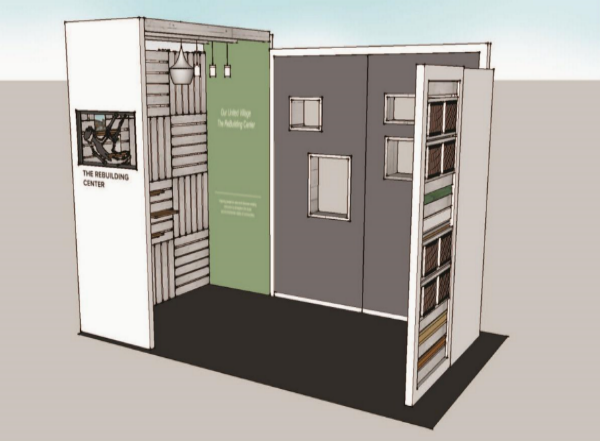
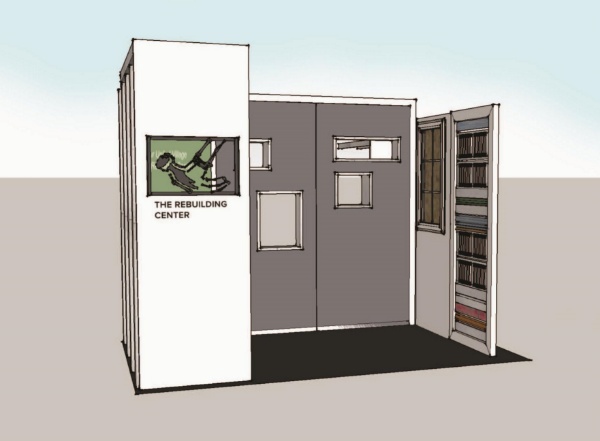
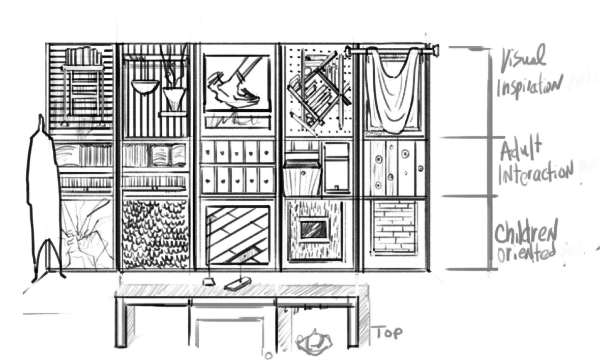
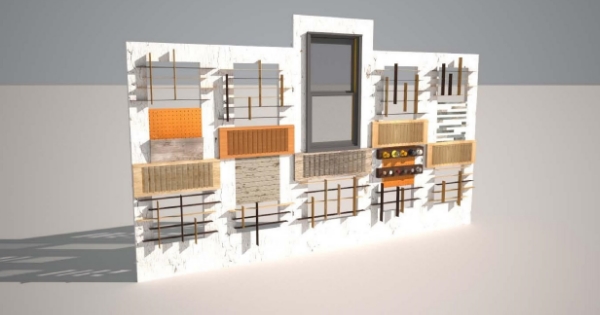
When the trade show booth was its developing stages, there were many ideas thrown out on what to incorporate; a mini museum, showcasing objects found at DeConstruction sites; a photo gallery displaying photos of homes through the DeConstruction process. The students had to respond to technical challenges such as how to include video aspects like the kiosks or how supply lighting without being reliant on an electrical source. They played with the idea of magnets and incorporated a metal sheet into their design. Students found ways to use both rough and finished pieces to show the range of materials available at the ReBuilding Center.
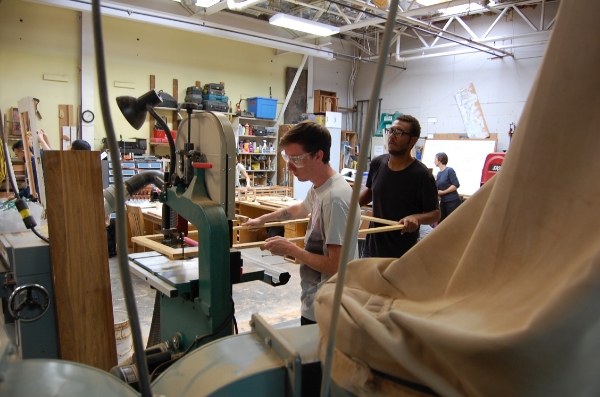
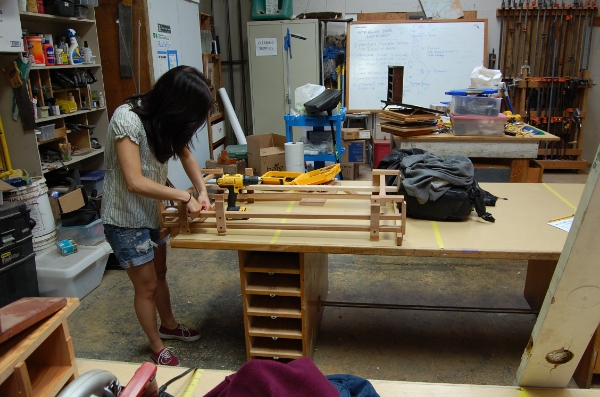
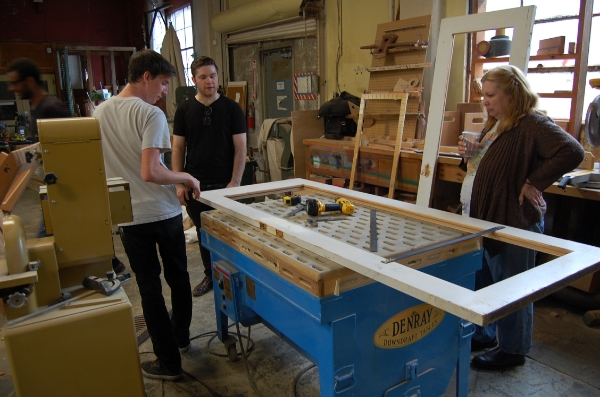
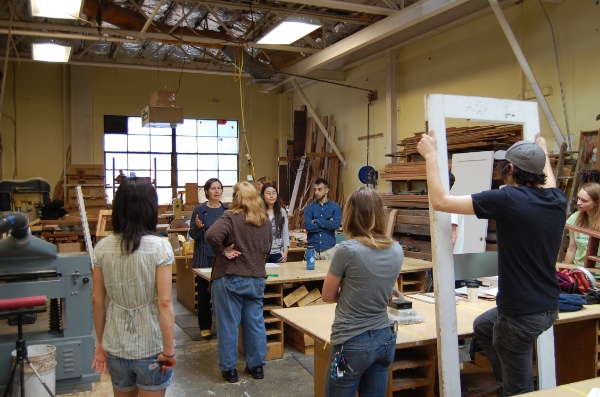
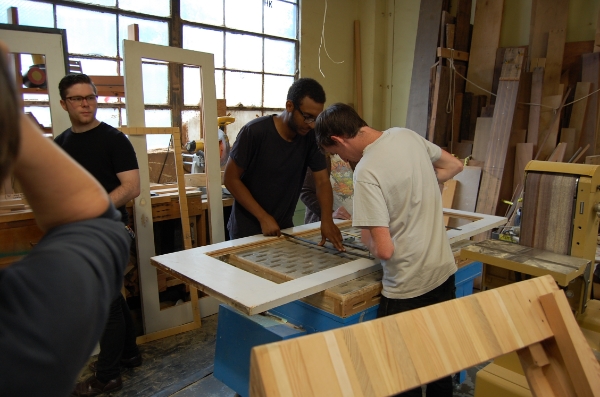

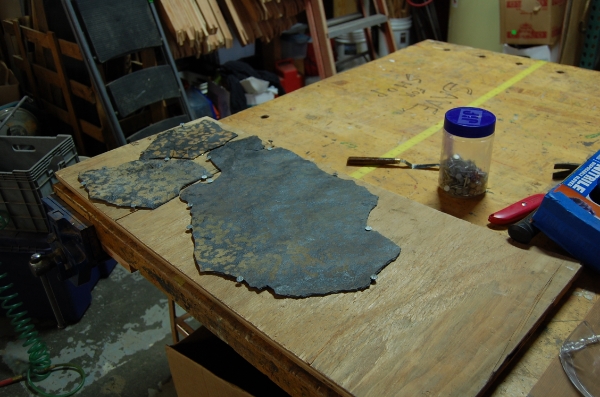
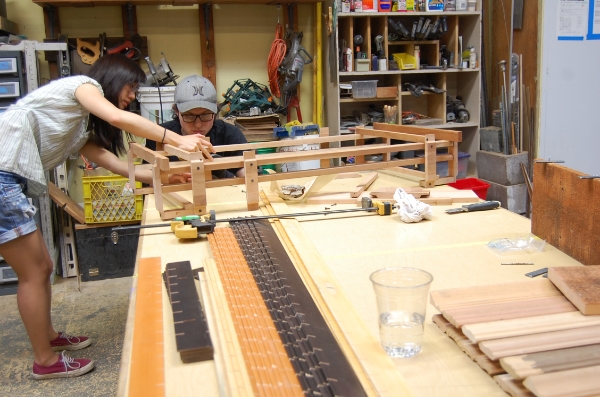
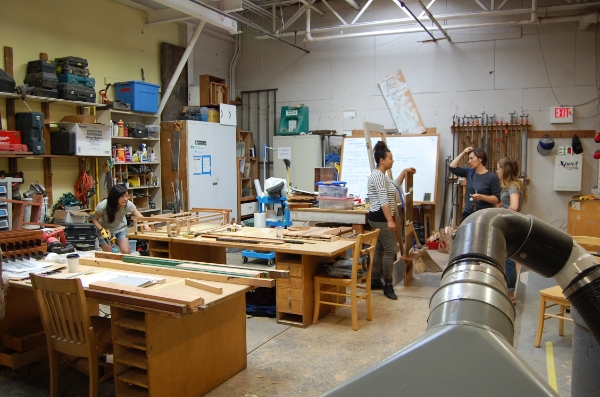
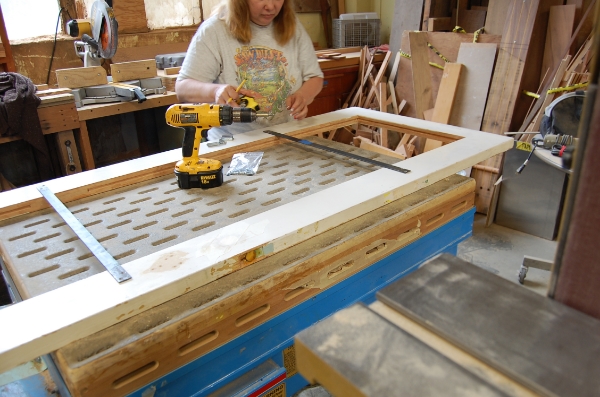
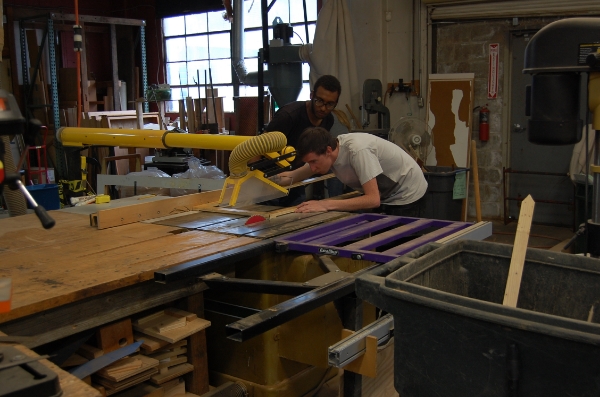
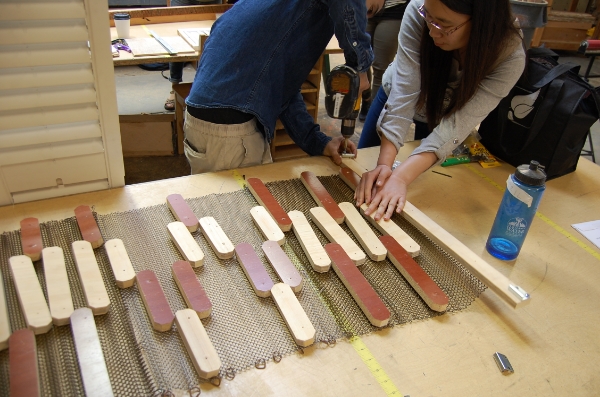
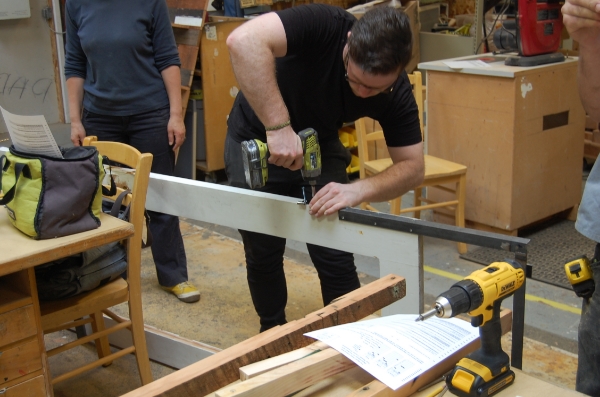
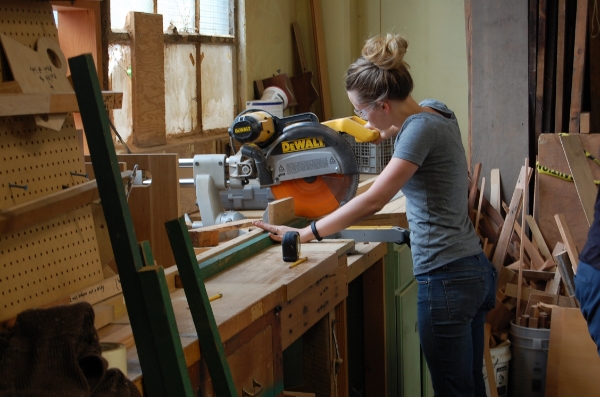
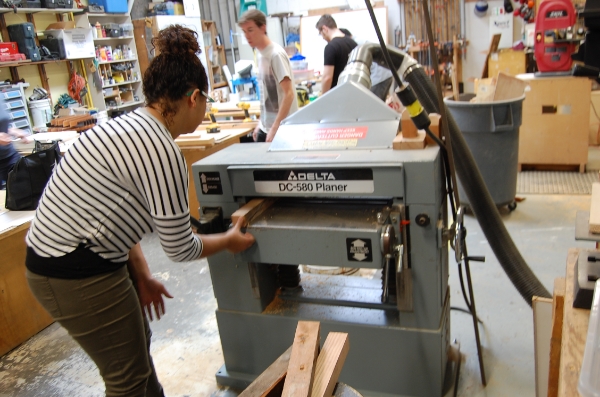


To keep the concept fluid throughout, certain guidelines had to be meet. Size constraints were established to be sure the booth was booth mobile and easily transported. Structural integrity had to considered due to the wear and tear, and possible damage over time.
Day of Service: RBC & AAAH help stem displacement of long-term homeowners in N/NE Portland
The ReBuilding Center in collaboration with the African American Alliance for Homeownership (AAAH) began an inaugural “Day of Service” this last Saturday, June 11th, an event that helps stem displacement of long-term residents of N/NE Portland. Staff from the ReBuilding Center and AAAH as well as dozens of volunteers showed up bright and early on Saturday morning, coffee in hand, to get going on some home repairs for members of their community. We focused on five different projects ranging from cement pouring to yard work to house painting. It was a powerful experience to be able to talk to homeowners and hear their stories, perspective on the development of the area, and about the complexity of issues surrounding gentrification.
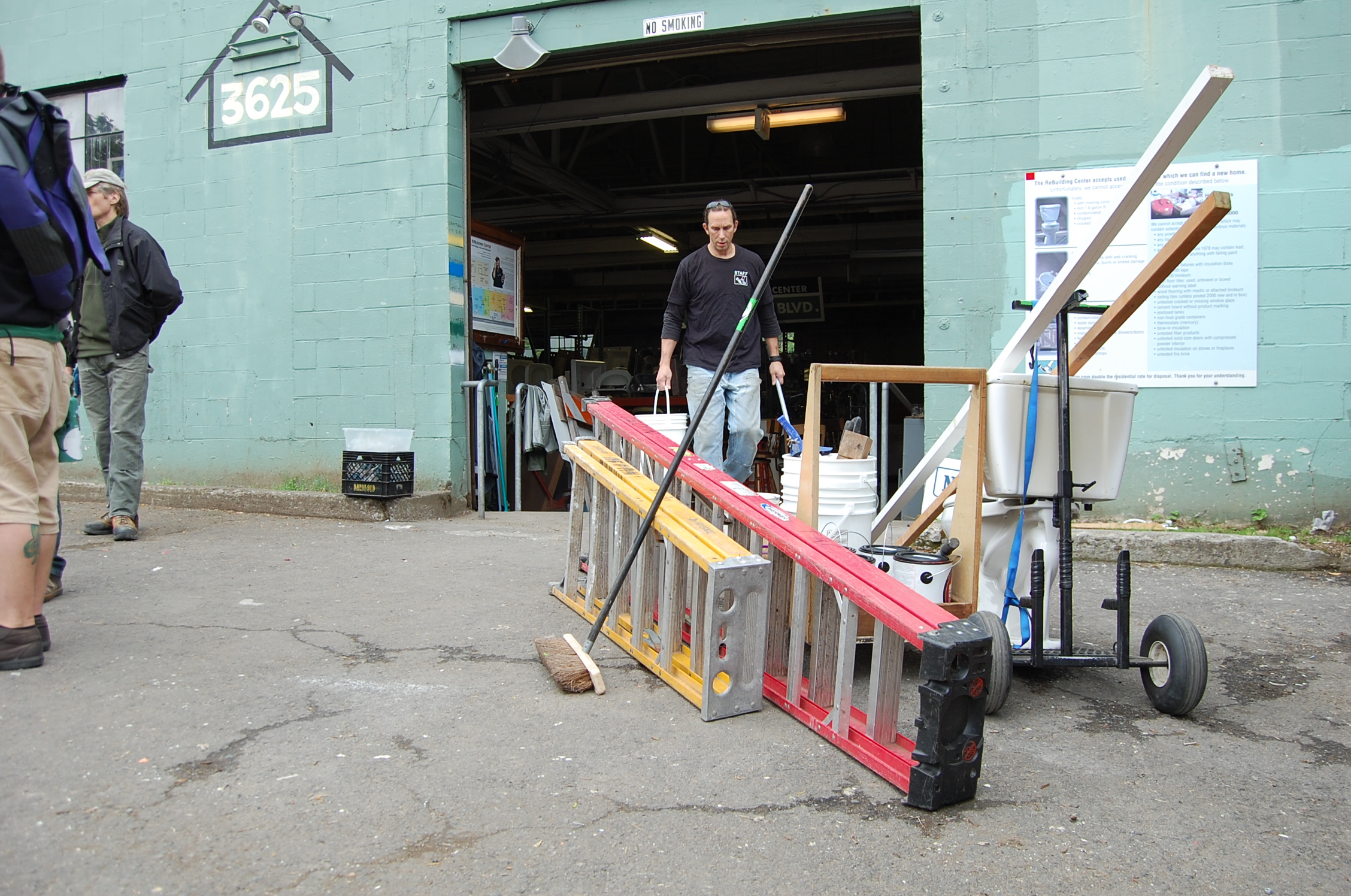
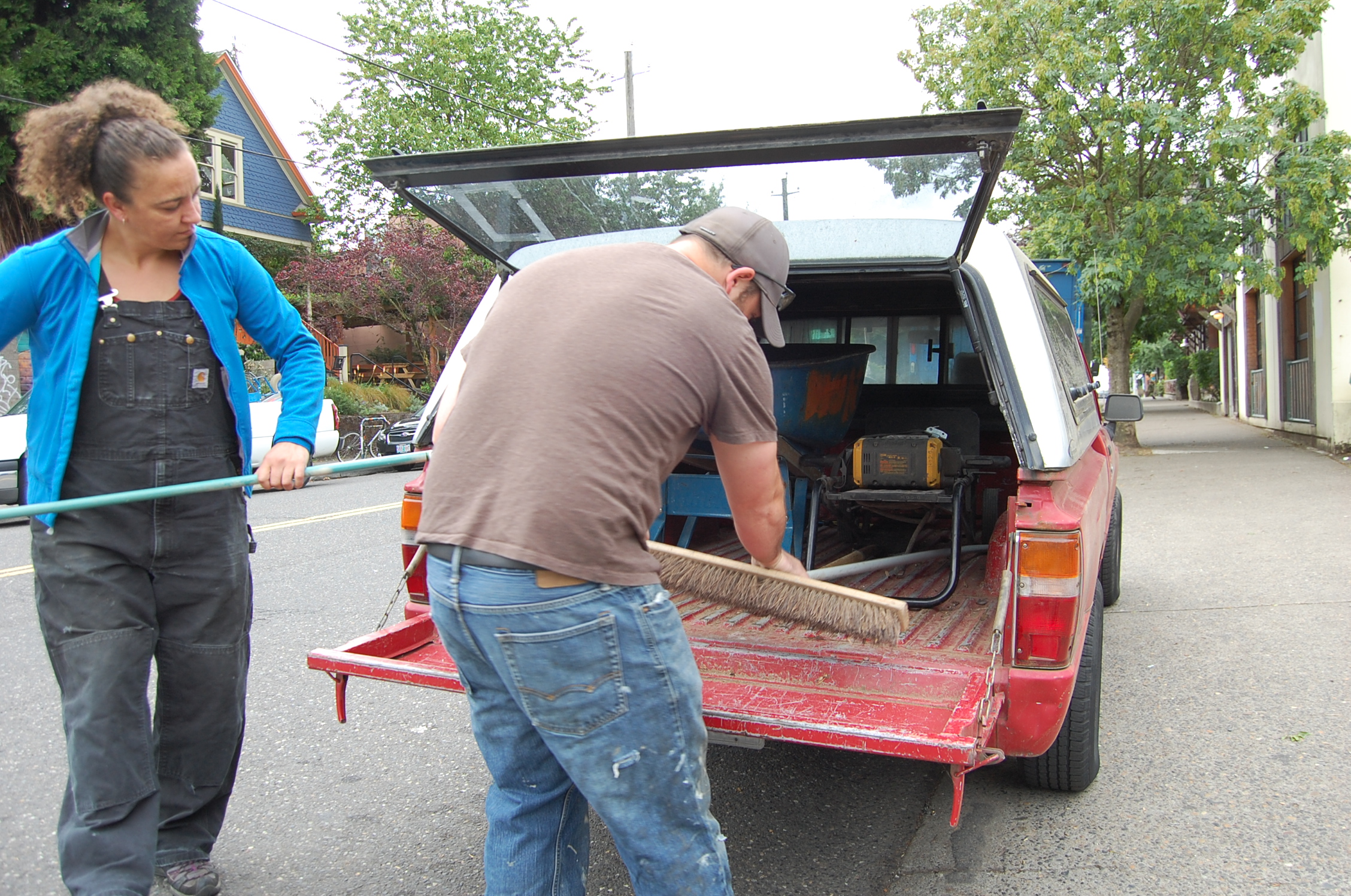

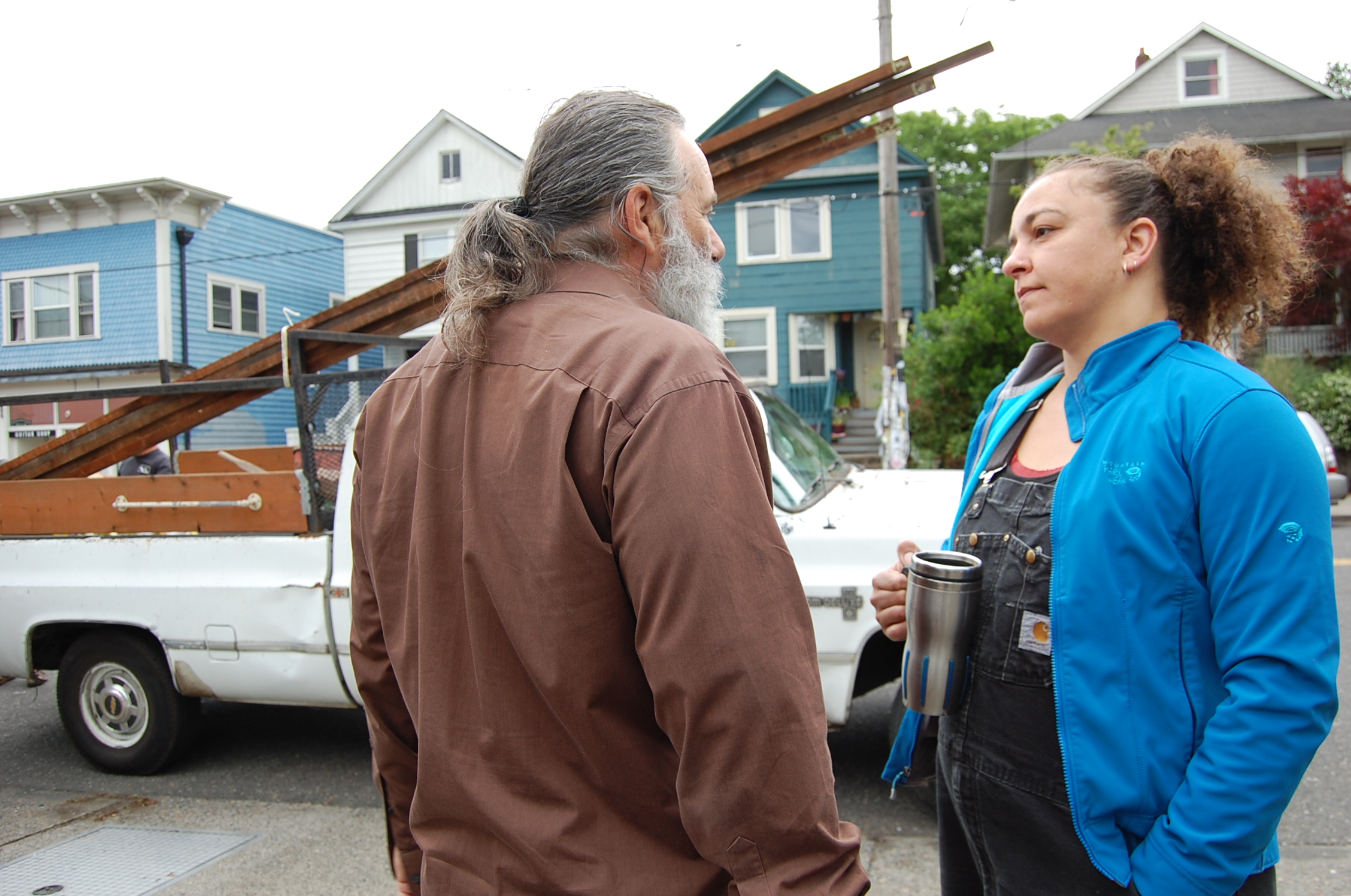

Ruth
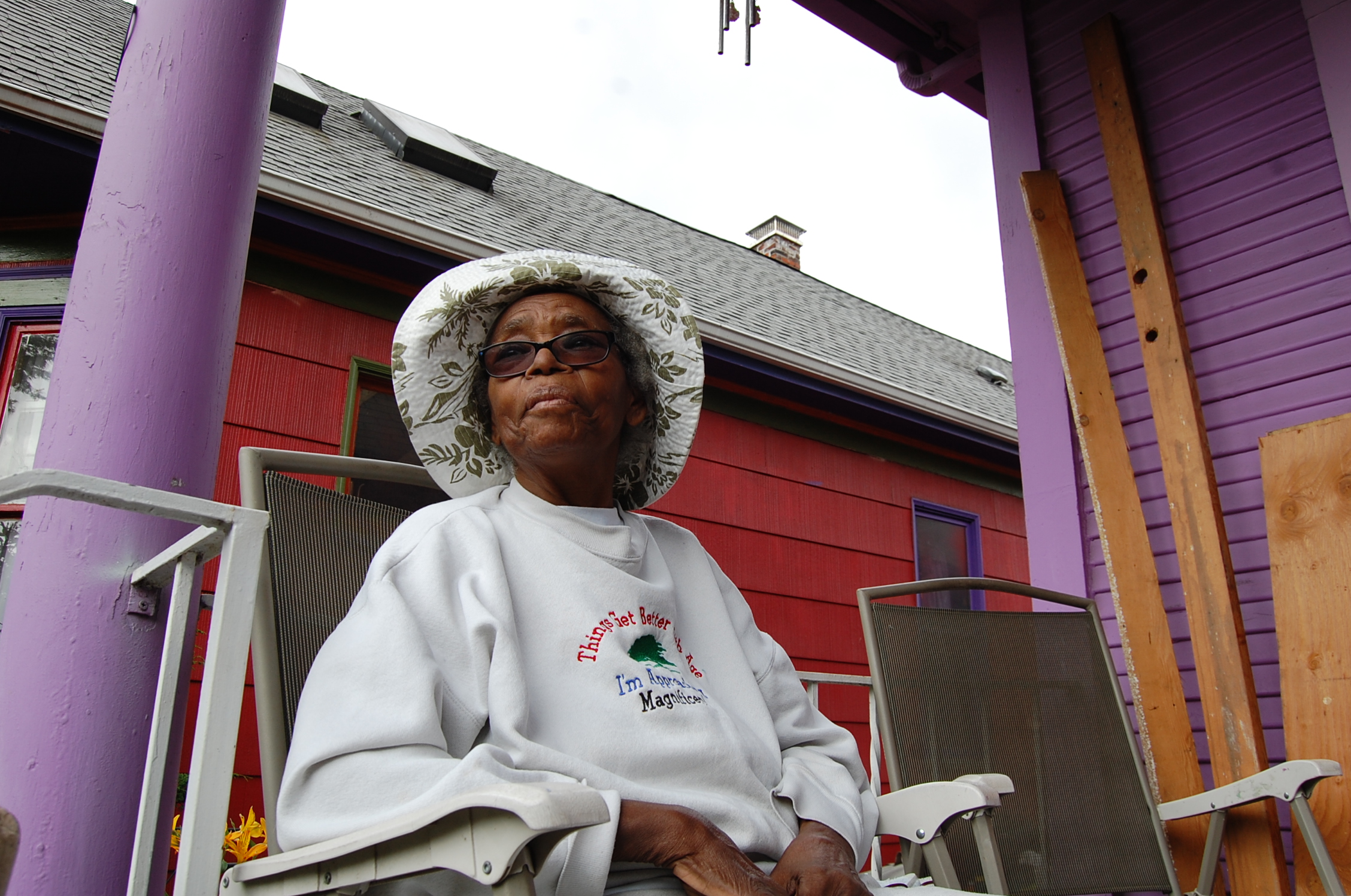
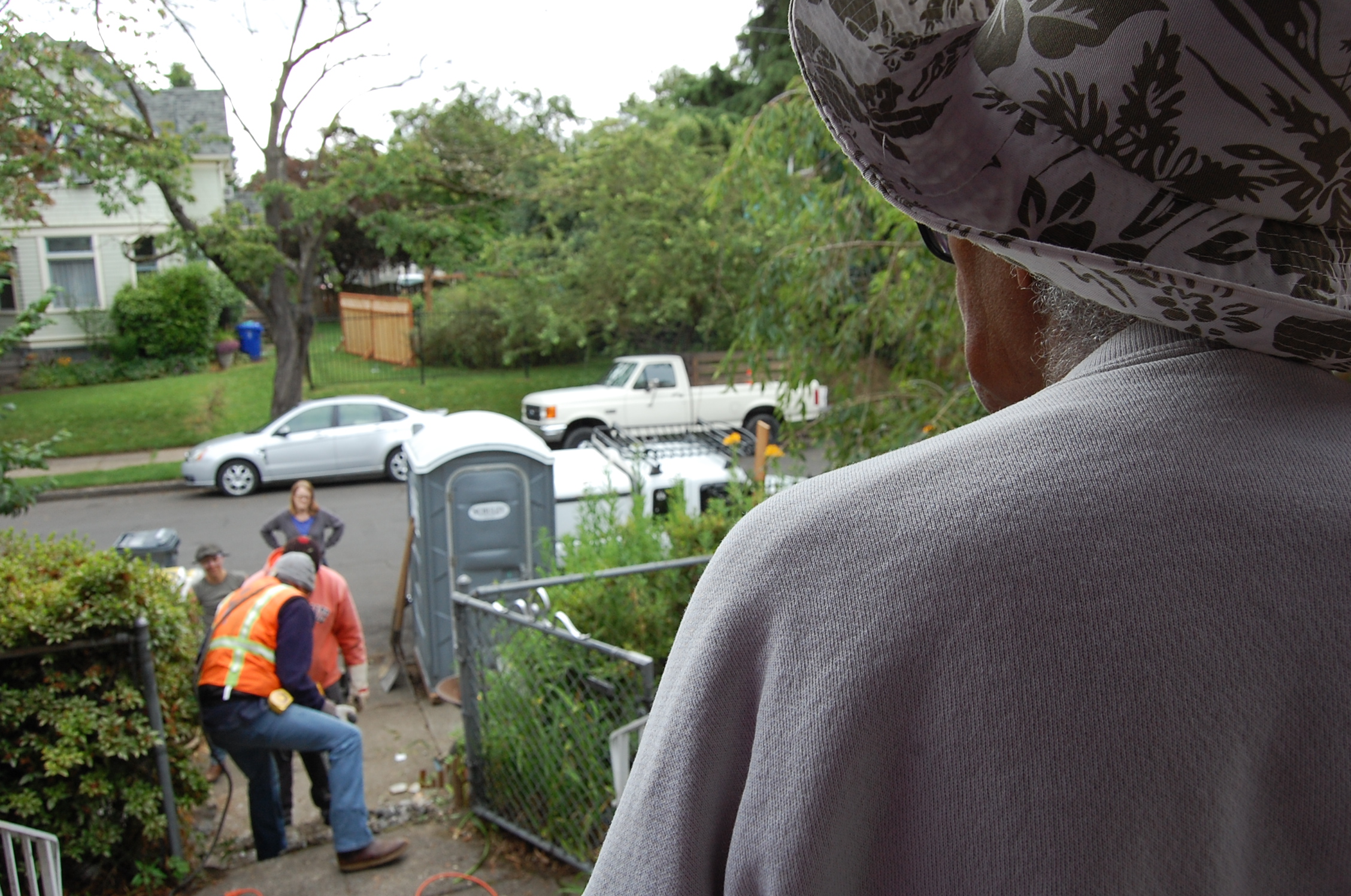
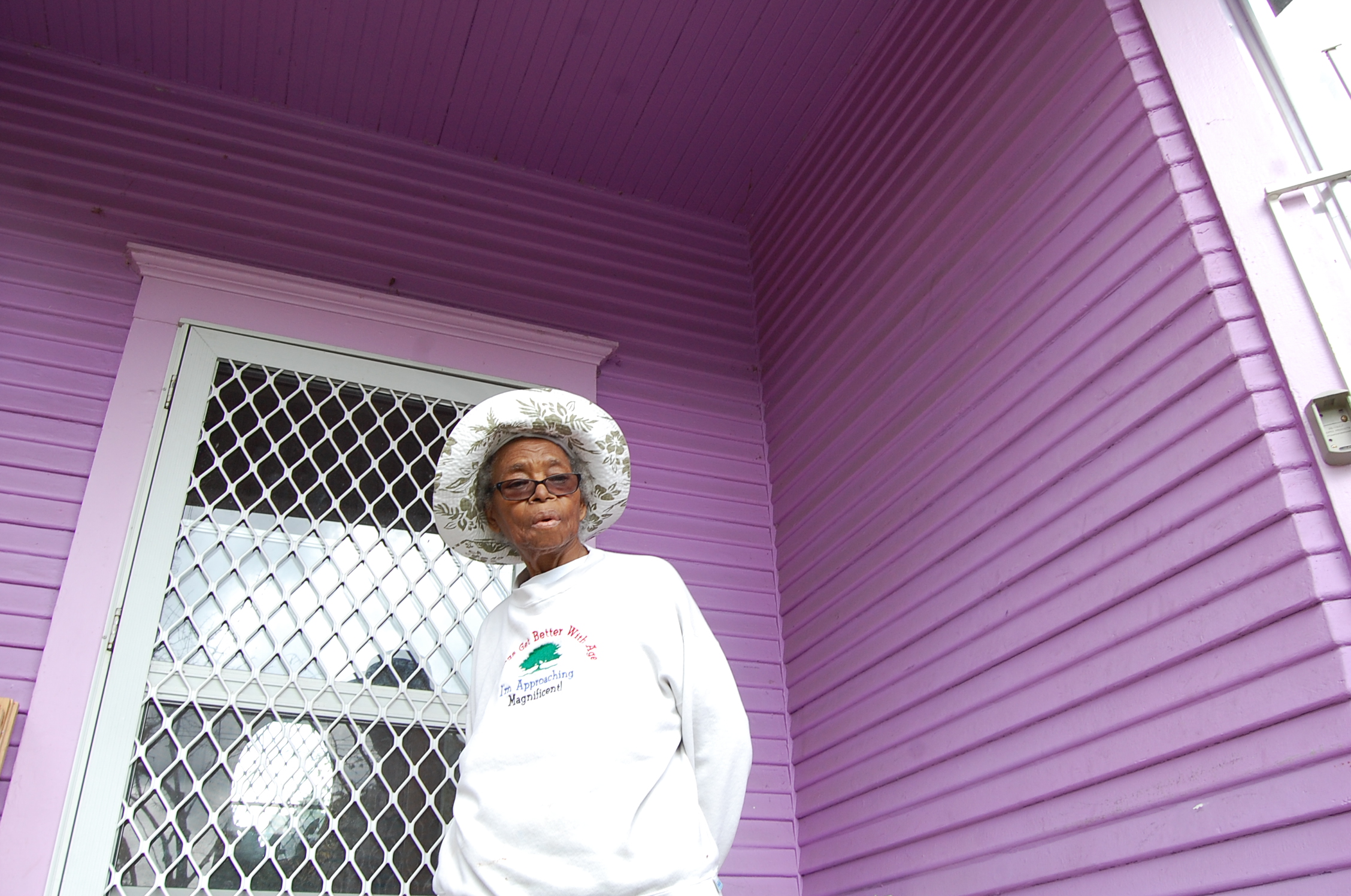
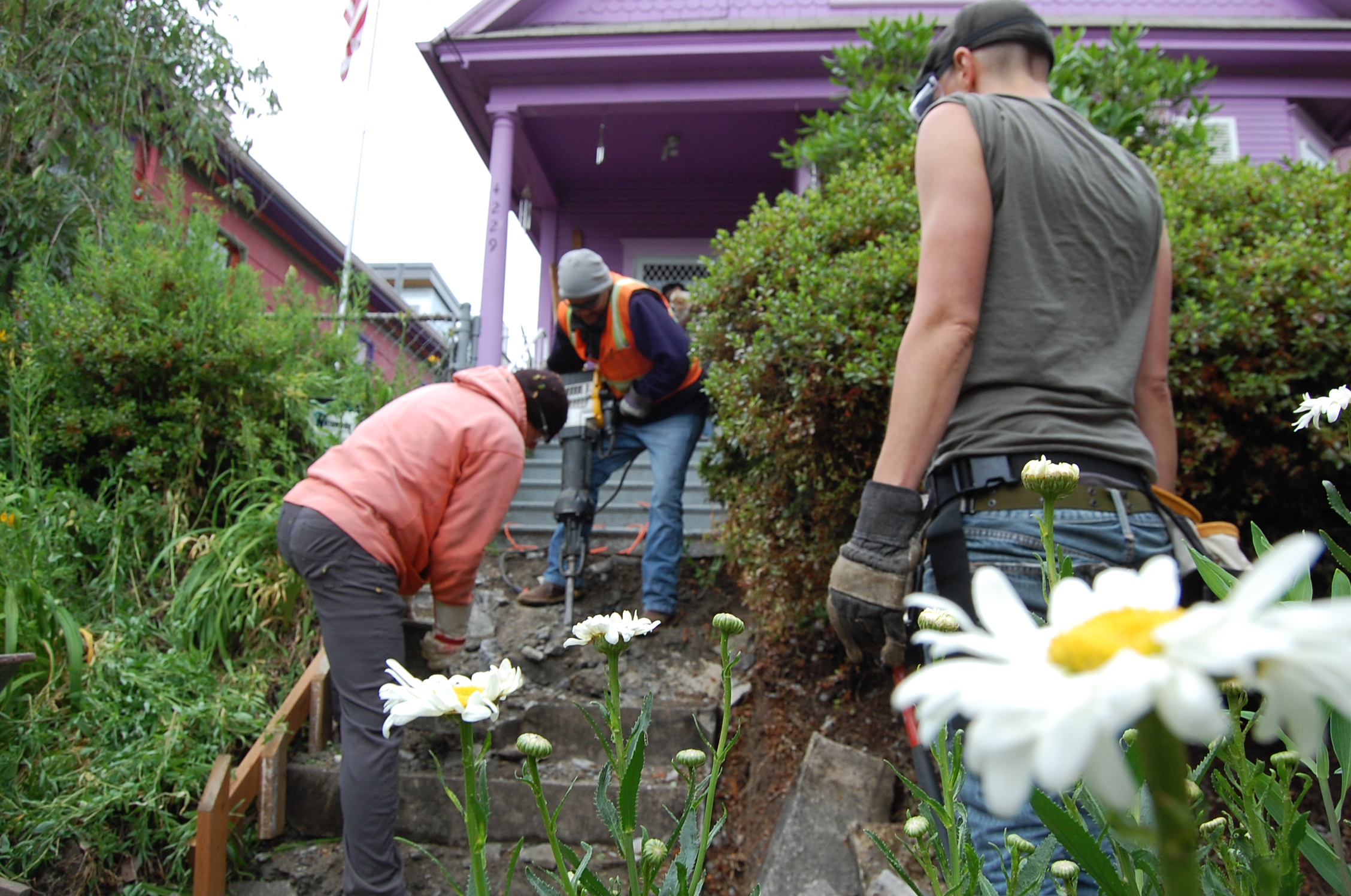

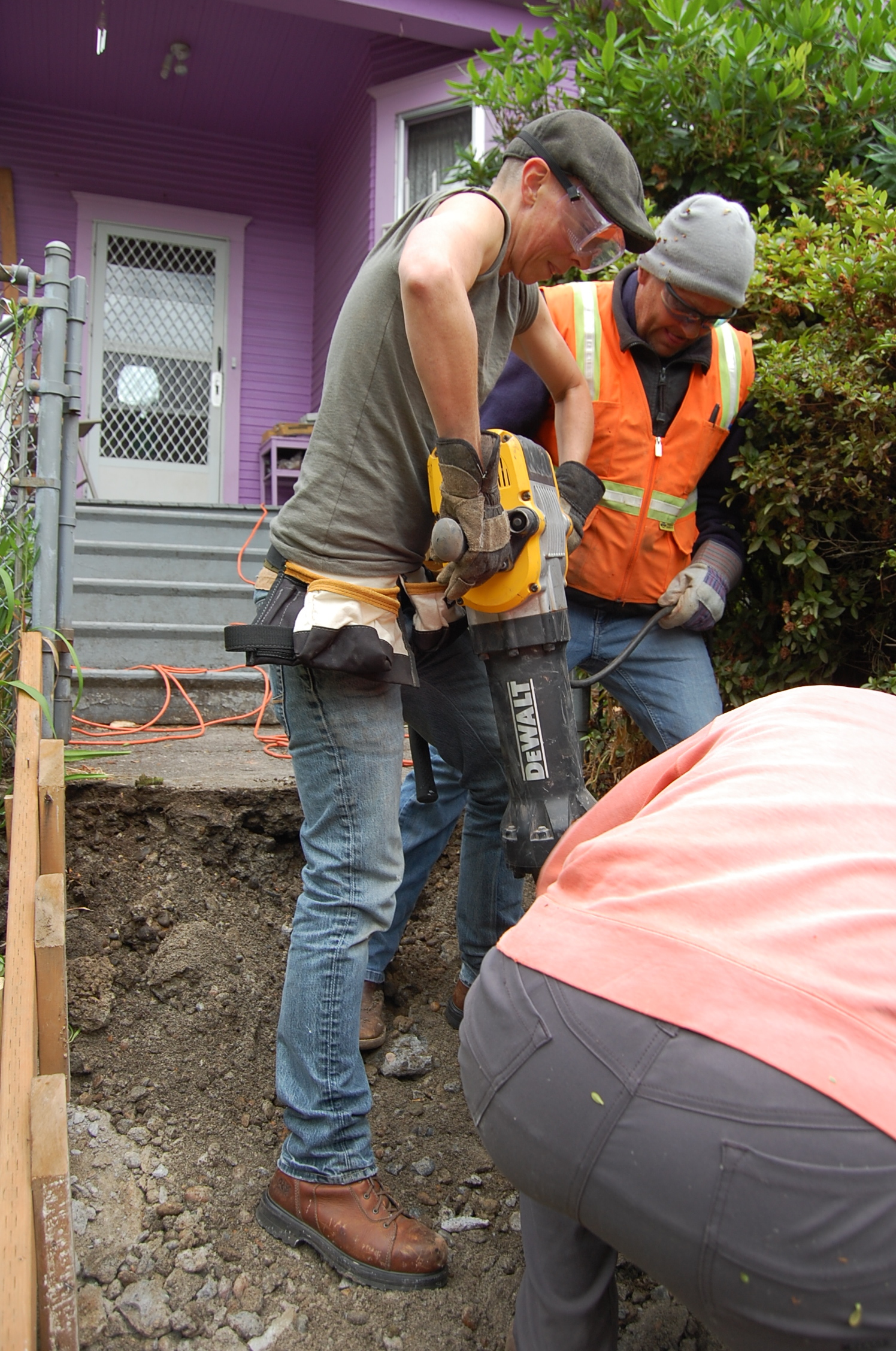
Since 1958, Ruth has seen her neighborhood transition through three distinct phases. When she first moved into her home 58 years ago, she remembers the area as a vibrant community where you could find everything you needed from food markets to a 10 cent store. She then witnessed the street experience heightened crime rates due to a stronger gang presence. Now she refers to the streets as “clean” and has seen the area turn into a once again bustling neighborhood. And no, she doesn’t want to sell. Every week she receives offers, people trying to buy her home. How could she leave her beautiful lavender home where she’s raised her kids and grandkids? With age, it has become increasingly difficult to keep up with the house and the garden. Years ago, during an earthquake, the cement stairs leading to Ruth’s home broke and it’s been hard for her to get down the stairs ever since. ReBuilding Center staff and volunteers were happy to lend their skills to fill her new cement stairway.
Pat
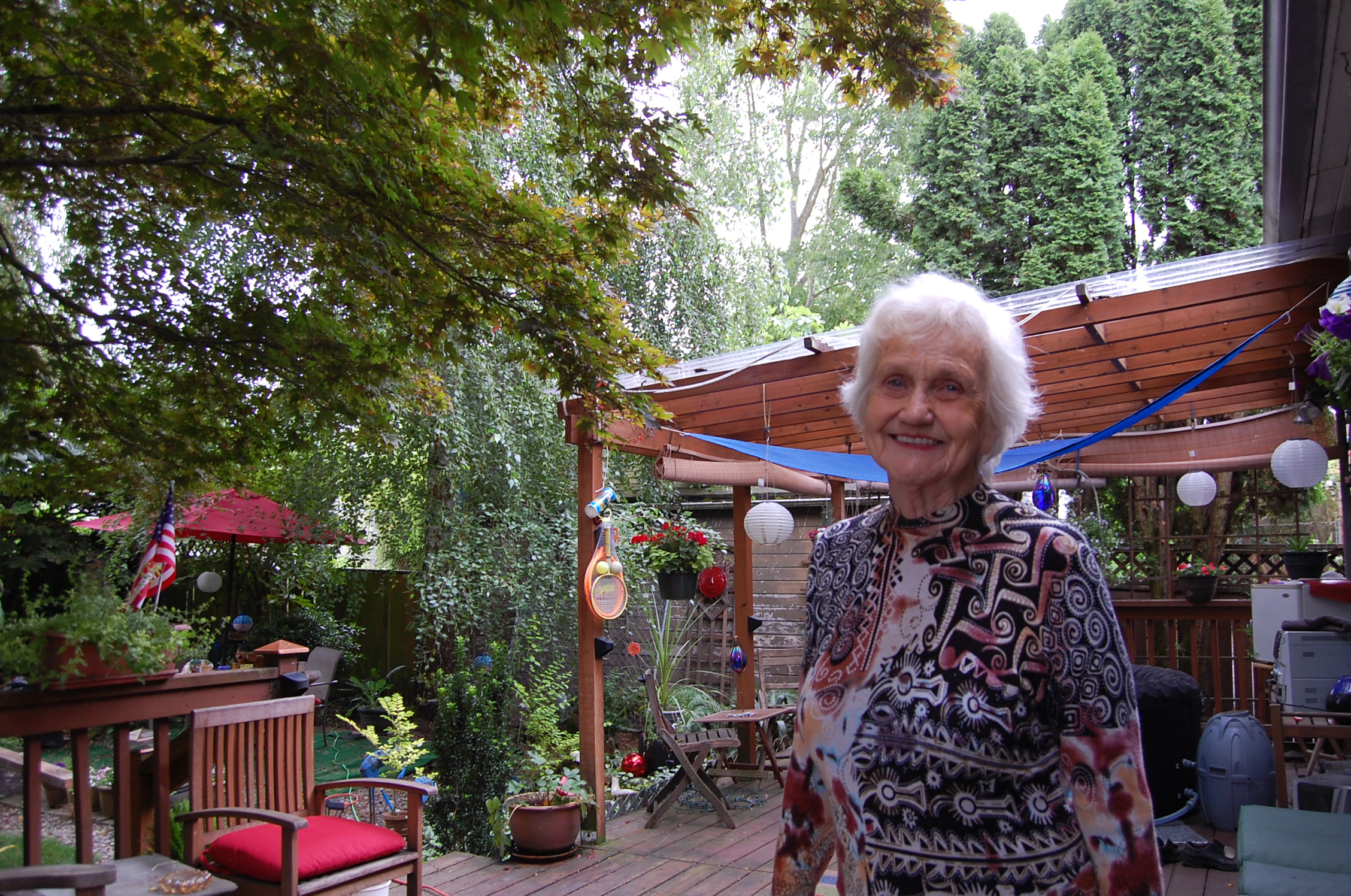
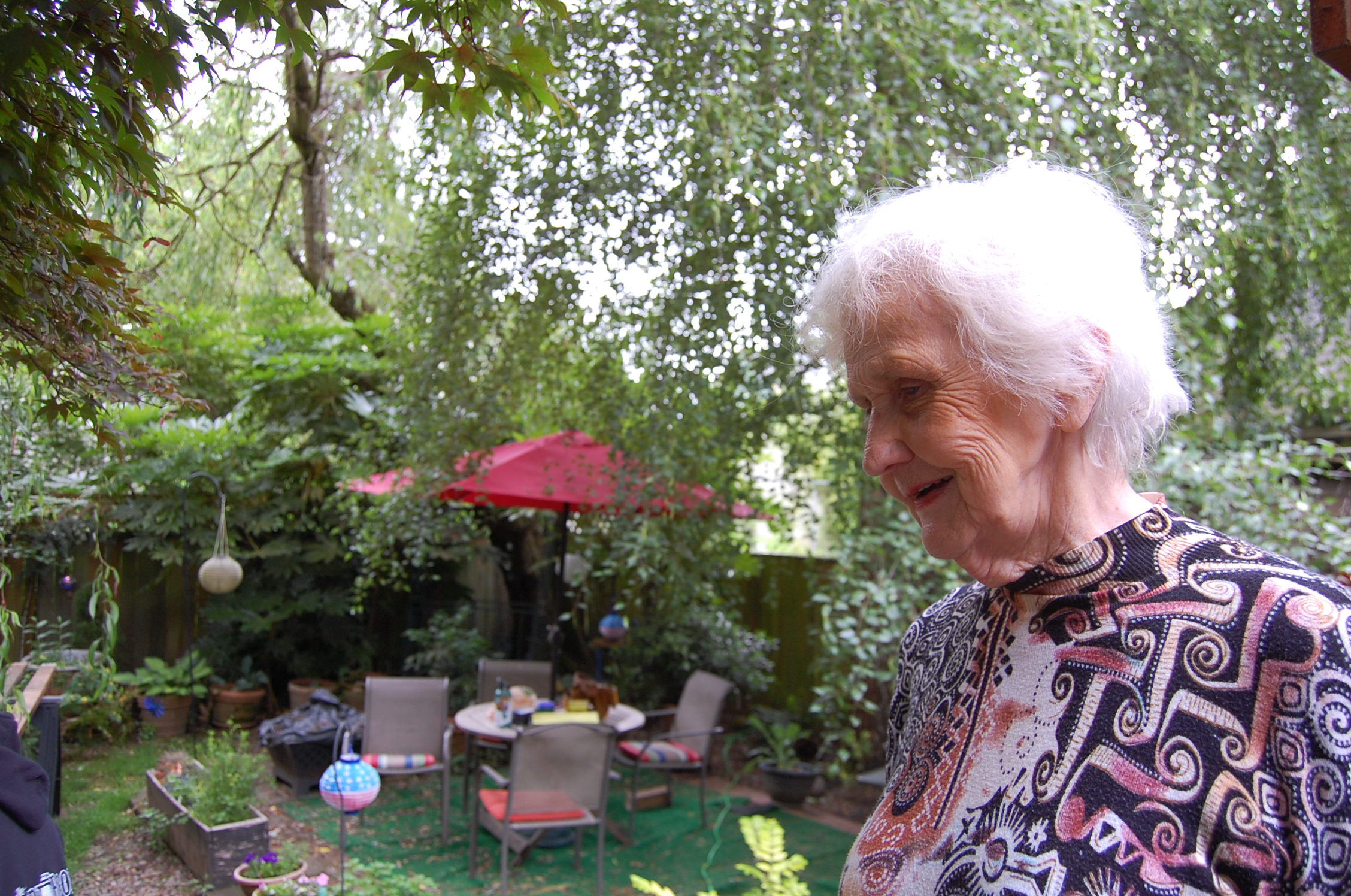
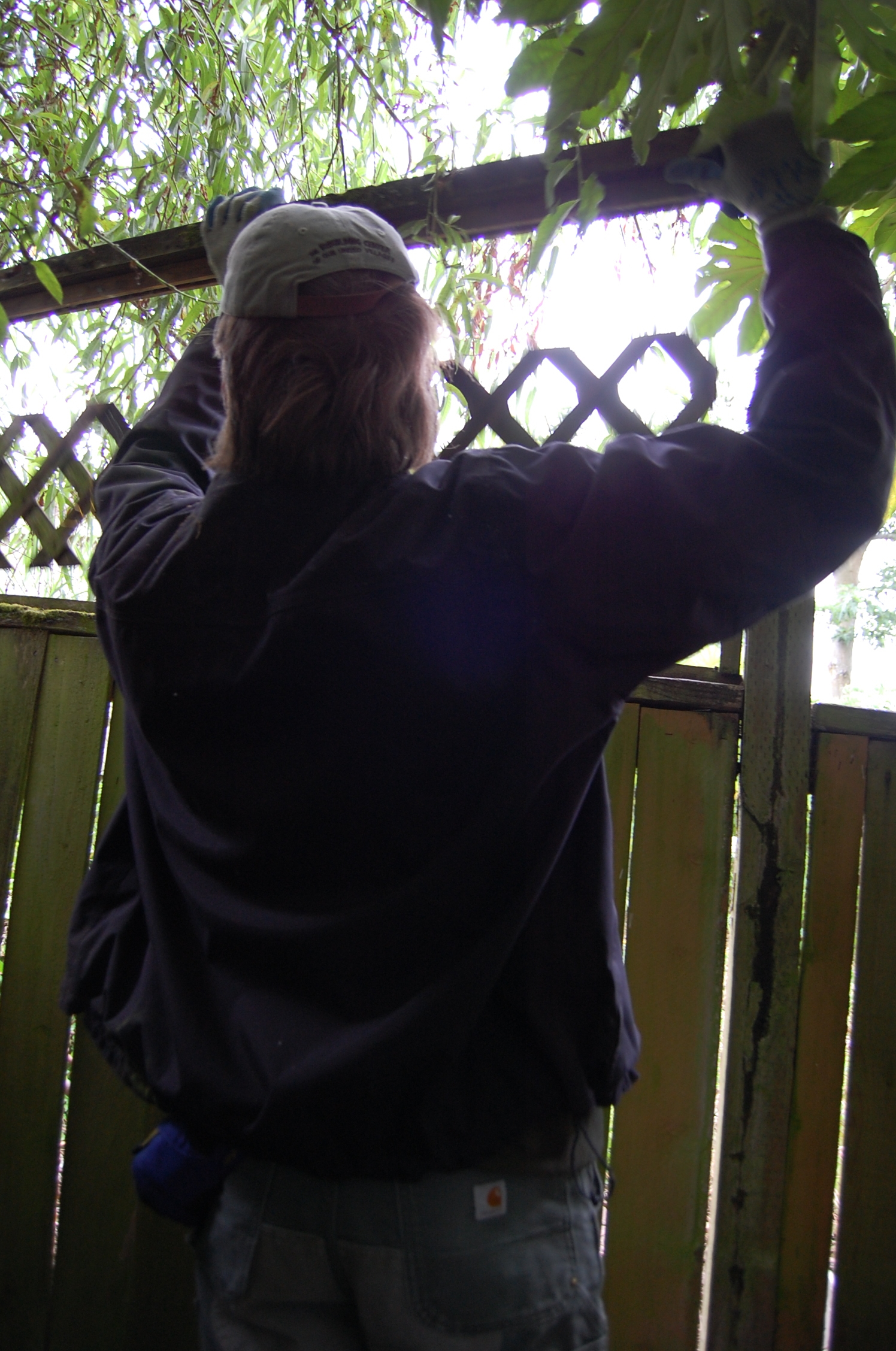
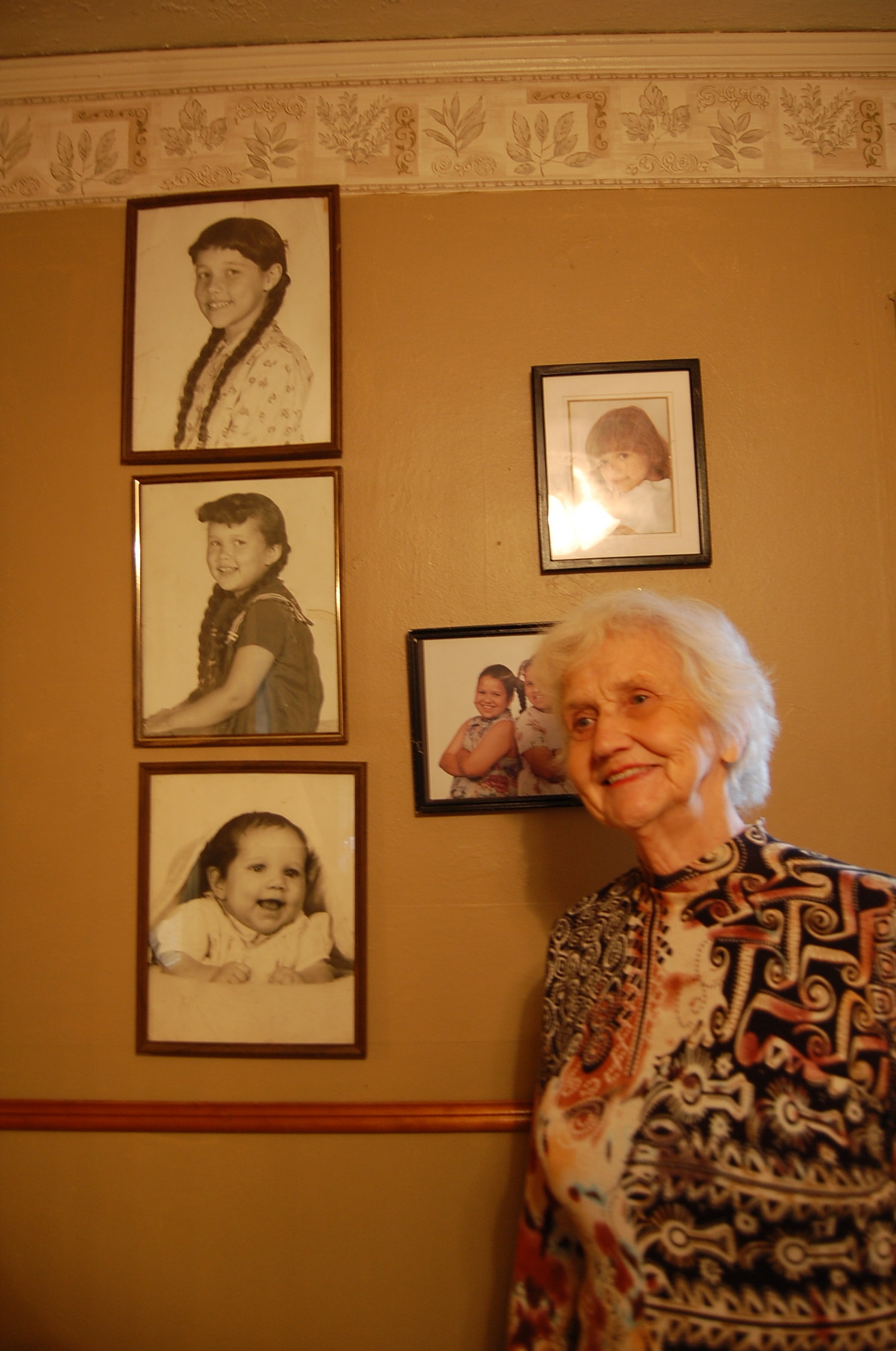
Pat is a real firecracker. Her creative and whimsical design sensibilities show throughout her home and yard. We helped Pat with her backyard, repairing a fence that she hasn’t been able to fix because of her arthritis. Pat loves to walk and reminds us that “it’s just as important to keep your mind as active as your body when you’re older.” Pat’s lived in her house for over 42 years and can count on one hand how many long-term residents still live in her surrounding neighborhood. “Everybody’s been pushed out,” she says, “it’s strange to see how much change has happened in our neighborhood.” A perk of the new development? Pat enjoys frequenting the new restaurants popping up in her area, serving hip and affordable fare during happy hour.
Elaine & Milhouse
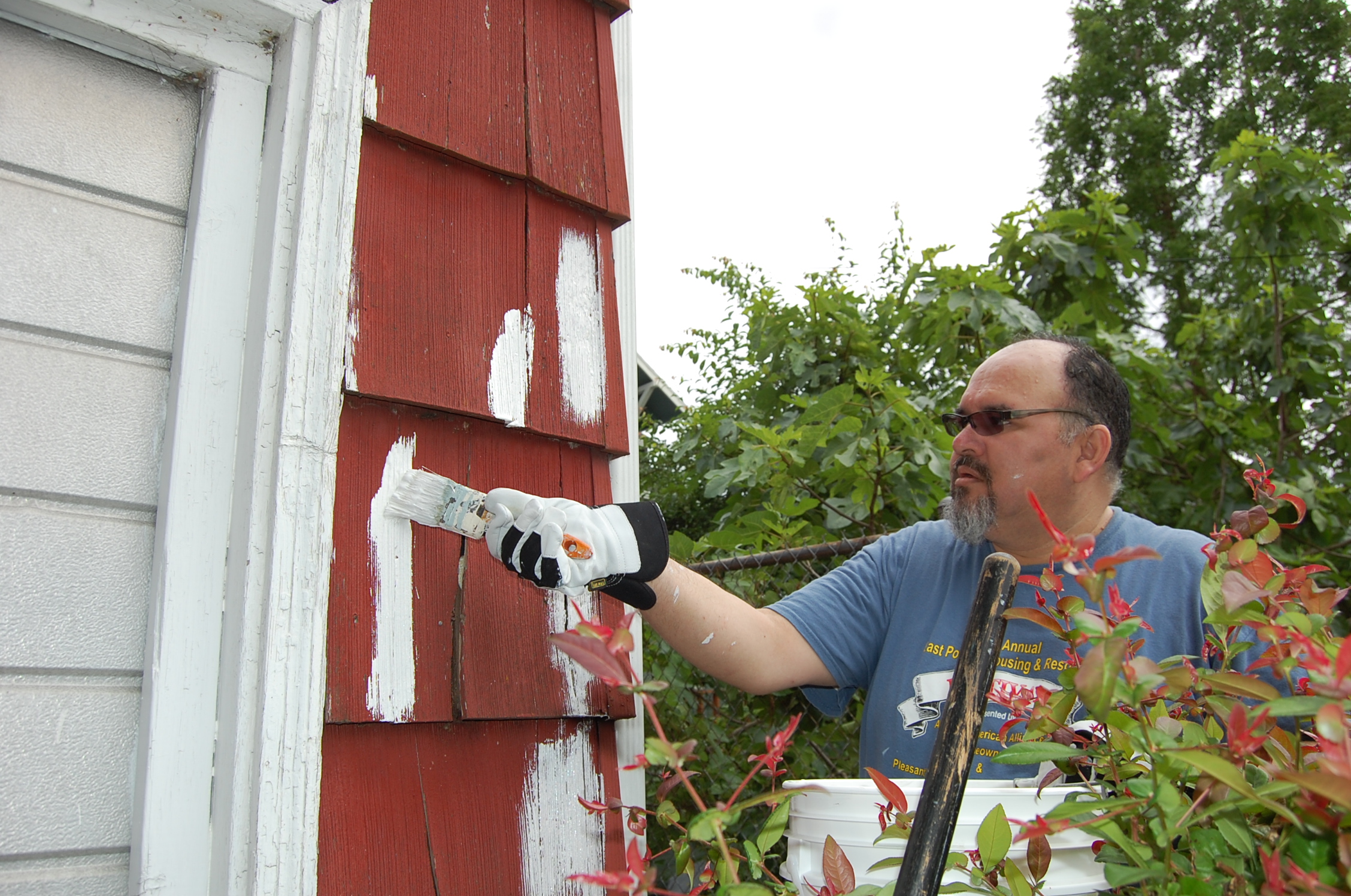
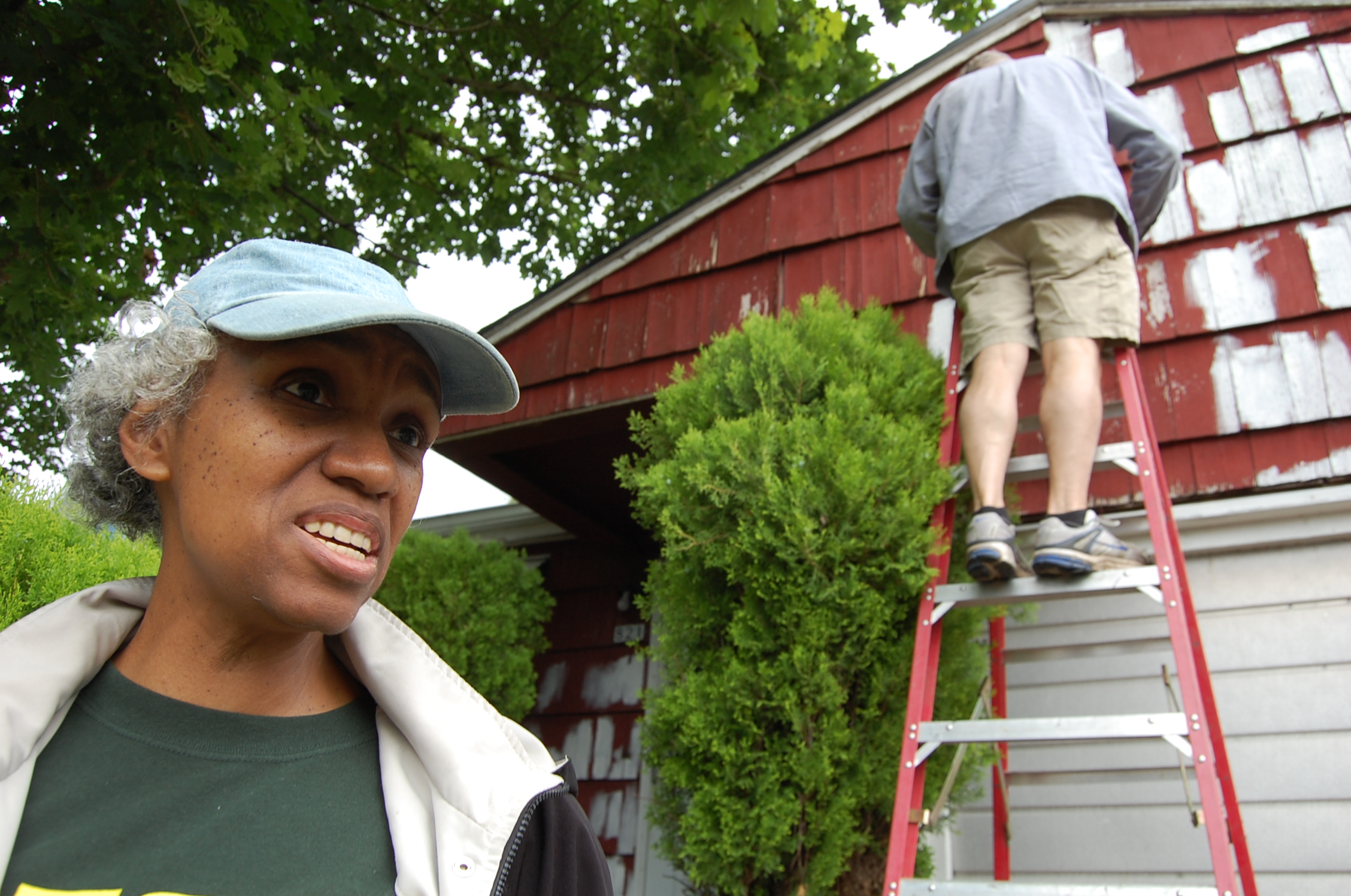

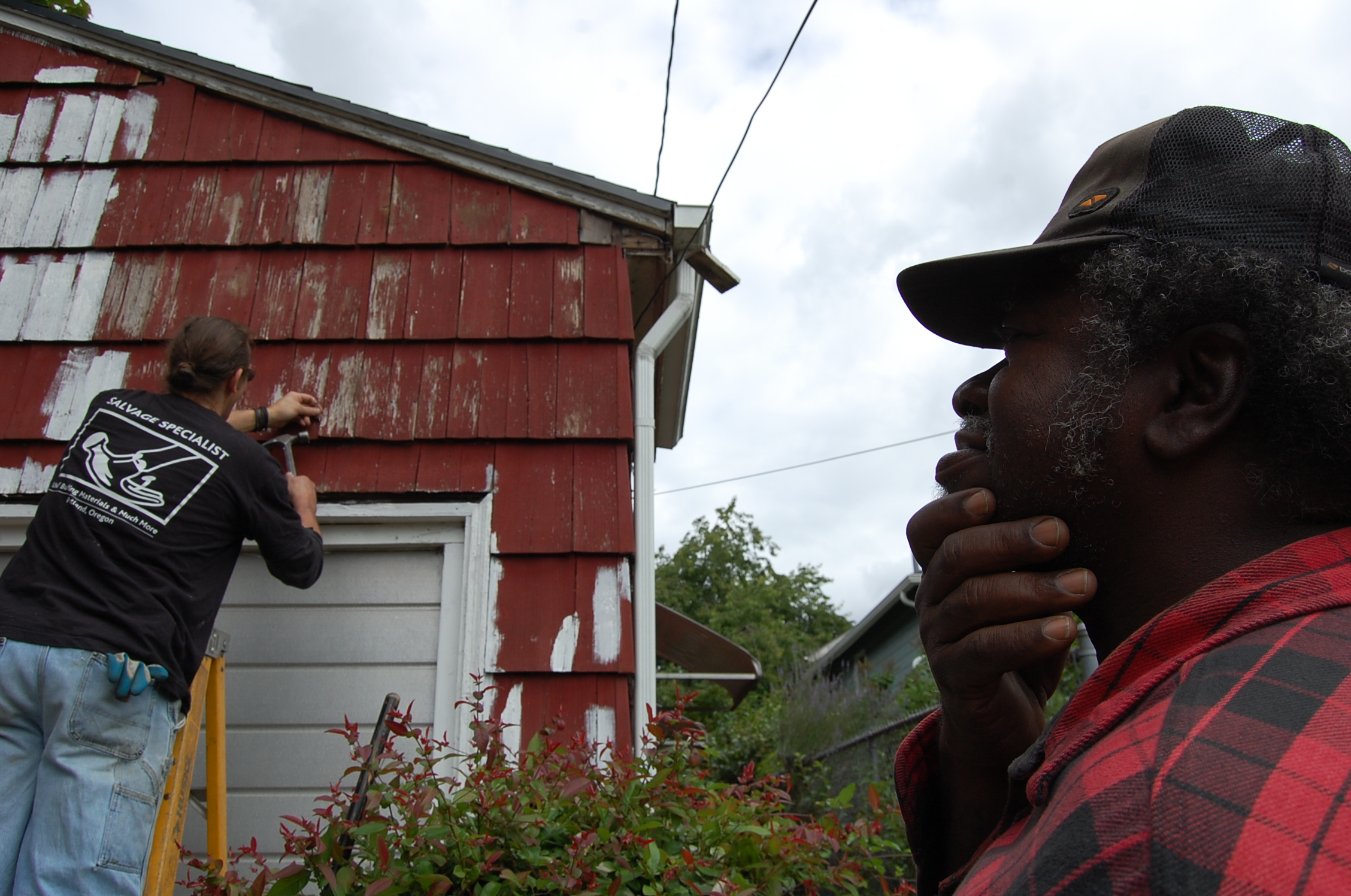
Elaine & Milhouse bought their home back in 1991 and they have been wanting to touch-up their house paint for a while now. They feel like their home stands amidst the freshly re-done houses popping up next door. Within the last ten years, they say the worst part of the rapidly changing environment is the traffic on their busy street. Several parked cars have been hit. And although they’ve developed relationships with their new neighbors, Elaine says, “it doesn’t make you feel good when you don’t know your [old] neighbors anymore.” With Elaine’s full-time schedule as a care-giver, and both of them getting older, it’s hard for them to keep up with repairs. We were happy to meet some of their needs and get to know our neighbors!
Carly
Carly was the youngest of the bunch but still stood witness to the dramatic changes to the neighborhood. She says, “it’s weird, every time I even drive to the ReBuilding Center, I see new stuff. Things are popping up so fast.” She believes it’s important to keep neighborhoods diverse. She tries to see all the change as positively as she can but wishes that it didn’t mean destroying what was already there. Carly doesn’t want Portland to look like every other city. She grew up in Portland and feels like it breeds a certain kind of nutty person. With affordable housing becoming more and more scarce, she worries about our houseless populations, especially families because of how hard it would be for them to adjust. Working at Kruger Farms and doing all of her own home repairs (using almost solely materials from the ReBuilding Center), Carly’s thought about renting out her house but doesn’t have very many options to choose from. It was a pleasure to help out with a few projects that required specific skill sets, such as cementing and rerouting a drain pipe.
ShaRee
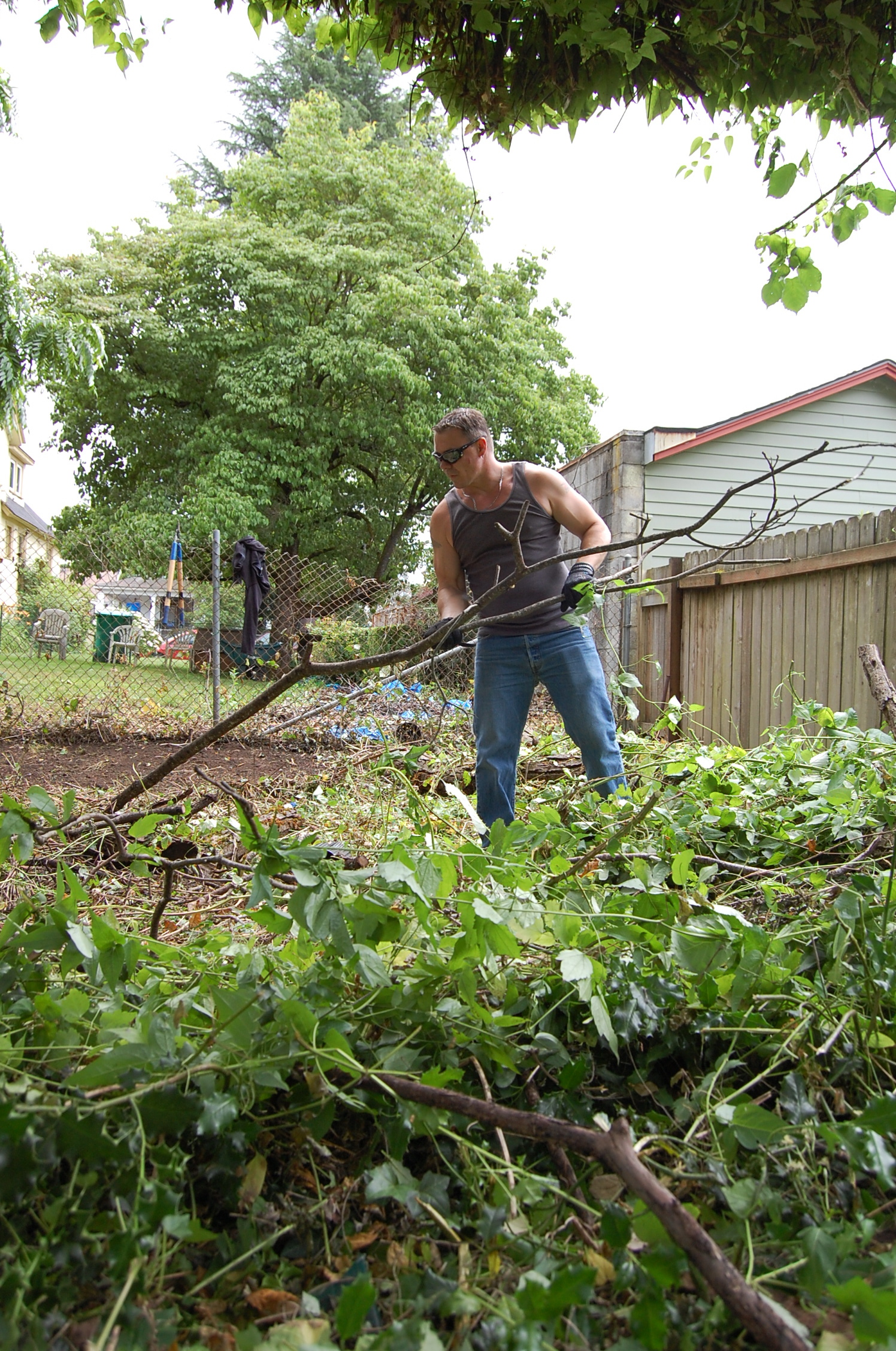
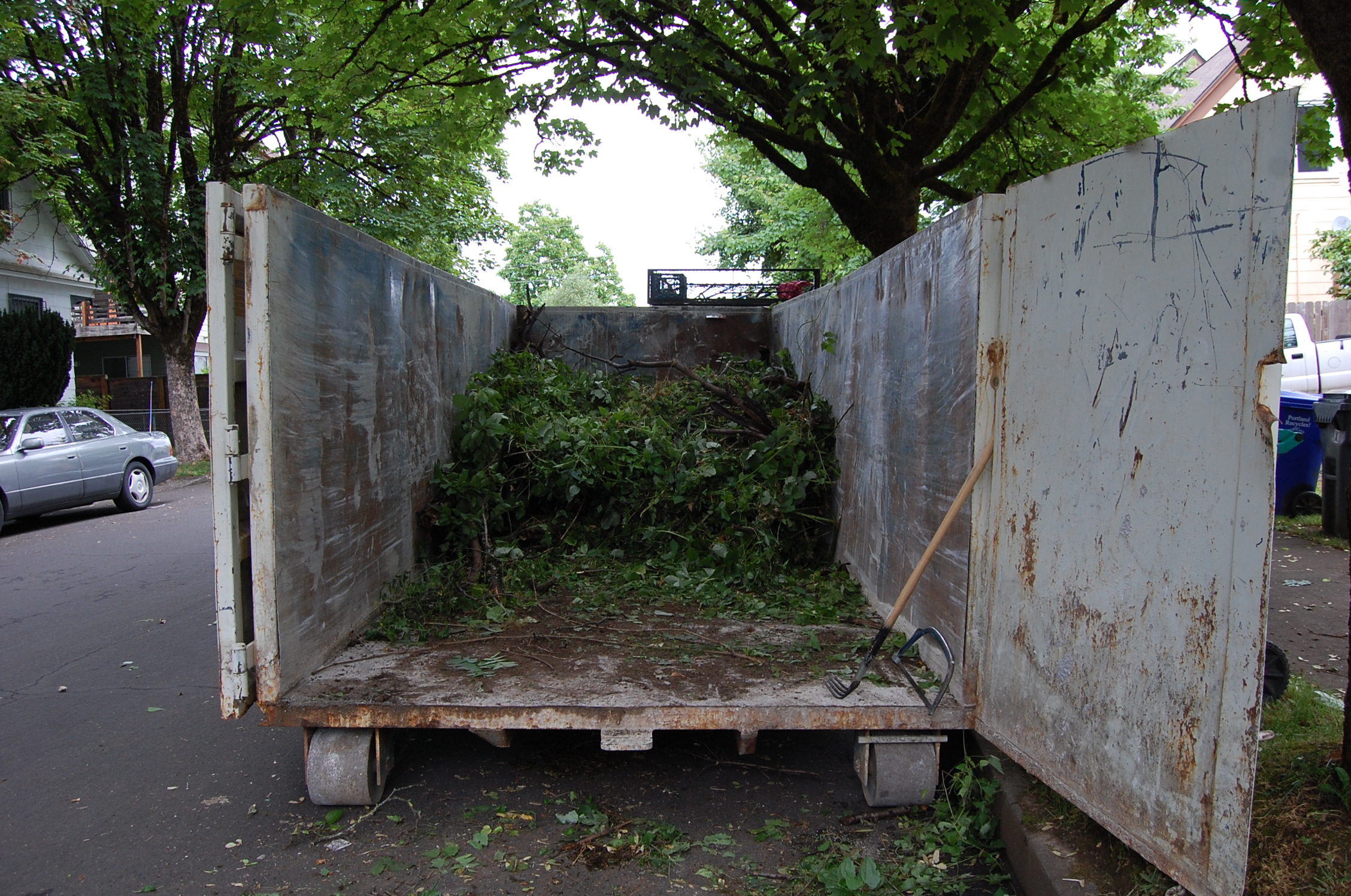
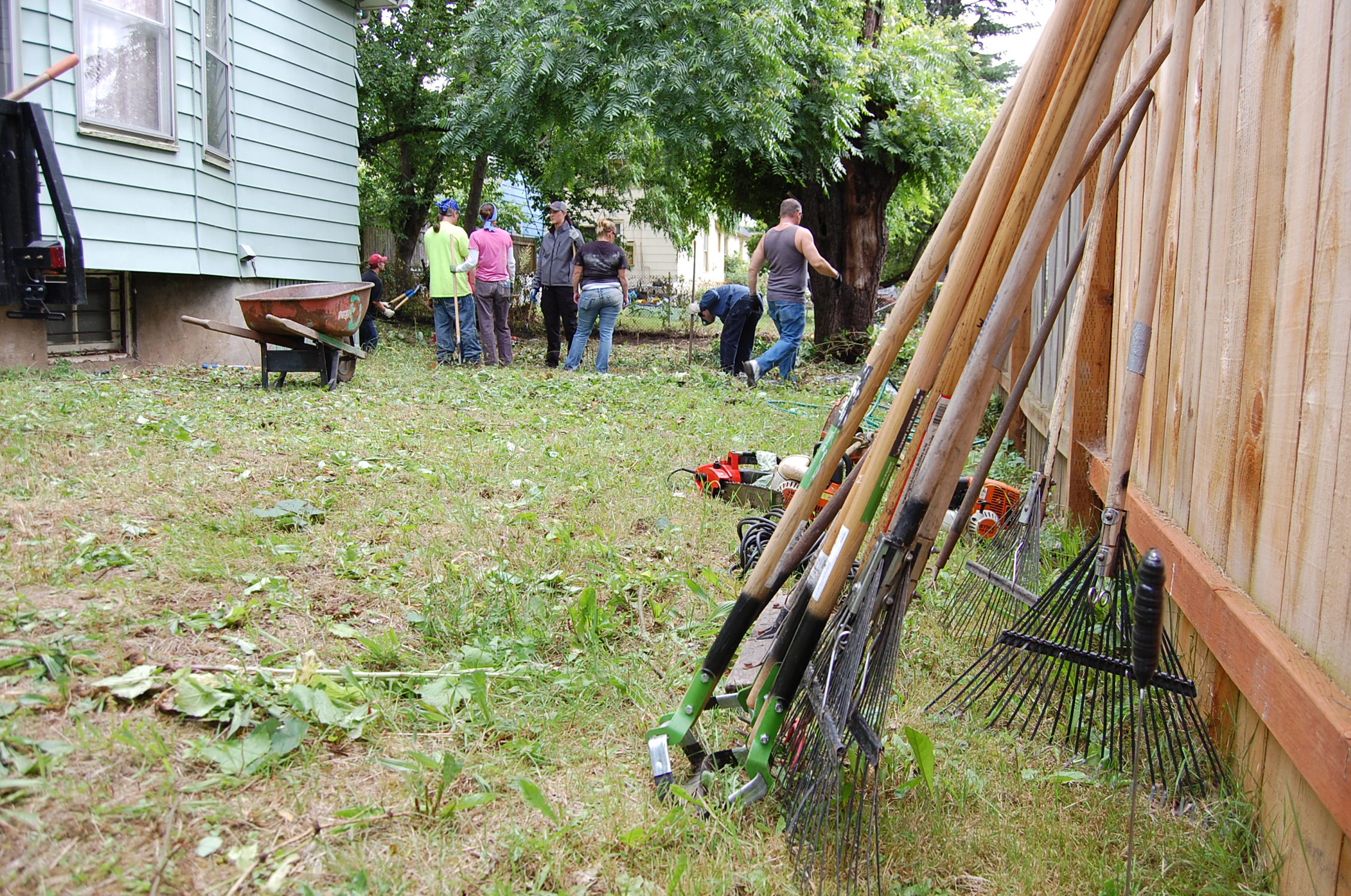
We also served another long term resident named ShaRee with her backyard. Twelve crew members weed-wacked and trimmed their way through a backyard jungle, yielding impressive results.
A big thank you to City of Roses Disposal & Recycling for the drop box, Metro for providing paint, brushes, and a voucher for the drop box at Metro Transfer Station, Oregon Deli Co. and Mississippi Pizza Pub for their generous donations to feed all the volunteers and staff, as well as Stormbreaker Brewing, who provided a nice discount for the wrap-up celebration!
The Day of Service was so successful that we would like to make it a regular event!



